Ed Friedlander, M.D., Pathologist
scalpel_blade@yahoo.com
No texting or chat messages, please. Ordinary e-mails are welcome.

|

|
 |
 |
 |
 |
|
verify here. |
Cyberfriends: The help you're looking for is probably here.
This website collects no information. If you e-mail me, neither your e-mail address nor any other information will ever be passed on to any third party, unless required by law.
This page was last modified January 1, 2016.
I have no sponsors and do not host paid advertisements. All external links are provided freely to sites that I believe my visitors will find helpful.
Welcome to Ed's Pathology Notes, placed here originally for the convenience of medical students at my school. You need to check the accuracy of any information, from any source, against other credible sources. I cannot diagnose or treat over the web, I cannot comment on the health care you have already received, and these notes cannot substitute for your own doctor's care. I am good at helping people find resources and answers. If you need me, send me an E-mail at scalpel_blade@yahoo.com Your confidentiality is completely respected. No texting or chat messages, please. Ordinary e-mails are welcome.
 I am active in HealthTap,
which provides free medical guidance from your cell phone.
There is also a fee site at
www.afraidtoask.com.
I am active in HealthTap,
which provides free medical guidance from your cell phone.
There is also a fee site at
www.afraidtoask.com.
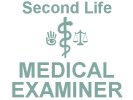 If you have a Second Life account, please visit my teammates and me at the Medical Examiner's office. |

|
 |
With one of four large boxes of "Pathguy" replies. |
 I'm still doing my best to answer
everybody.
Sometimes I get backlogged,
sometimes my E-mail crashes, and sometimes my
literature search software crashes. If you've not heard
from me in a week, post me again. I send my most
challenging questions to the medical student pathology
interest group, minus the name, but with your E-mail
where you can receive a reply.
I'm still doing my best to answer
everybody.
Sometimes I get backlogged,
sometimes my E-mail crashes, and sometimes my
literature search software crashes. If you've not heard
from me in a week, post me again. I send my most
challenging questions to the medical student pathology
interest group, minus the name, but with your E-mail
where you can receive a reply.
Numbers in {curly braces} are from the magnificent Slice of Life videodisk. No medical student should be without access to this wonderful resource.
 I am presently adding clickable links to
images in these notes. Let me know about good online
sources in addition to these:
I am presently adding clickable links to
images in these notes. Let me know about good online
sources in addition to these:
pathology.org -- my cyberfriends, great for current news and browsing for the general public
EnjoyPath -- a great resource for everyone, from beginning medical students to pathologists with years of experience
Medmark Pathology -- massive listing of pathology sites
Estimating the Time of Death -- computer program right on a webpage
Pathology Field Guide -- recognizing anatomic lesions, no pictures
Freely have you received, freely give. -- Matthew 10:8. My site receives an enormous amount of traffic, and I'm still handling dozens of requests for information weekly, all as a public service.
Pathology's modern founder, Rudolf Virchow M.D., left a legacy of realism and social conscience for the discipline. I am a mainstream Christian, a man of science, and a proponent of common sense and common kindness. I am an outspoken enemy of all the make-believe and bunk that interfere with peoples' health, reasonable freedom, and happiness. I talk and write straight, and without apology.
Throughout these notes, I am speaking only for myself, and not for any employer, organization, or associate.
Special thanks to my friend and colleague, Charles Wheeler M.D., pathologist and former Kansas City mayor. Thanks also to the real Patch Adams M.D., who wrote me encouragement when we were both beginning our unusual medical careers.
If you're a private individual who's enjoyed this site, and want to say, "Thank you, Ed!", then what I'd like best is a contribution to the Episcopalian home for abandoned, neglected, and abused kids in Nevada:

My home page
More of my notes
My medical students
Especially if you're looking for information on a disease with a name that you know, here are a couple of great places for you to go right now and use Medline, which will allow you to find every relevant current scientific publication. You owe it to yourself to learn to use this invaluable internet resource. Not only will you find some information immediately, but you'll have references to journal articles that you can obtain by interlibrary loan, plus the names of the world's foremost experts and their institutions.
Alternative (complementary) medicine has made real progress since my generally-unfavorable 1983 review. If you are interested in complementary medicine, then I would urge you to visit my new Alternative Medicine page. If you are looking for something on complementary medicine, please go first to the American Association of Naturopathic Physicians. And for your enjoyment... here are some of my old pathology exams for medical school undergraduates.
I cannot examine every claim that my correspondents share with me. Sometimes the independent thinkers prove to be correct, and paradigms shift as a result. You also know that extraordinary claims require extraordinary evidence. When a discovery proves to square with the observable world, scientists make reputations by confirming it, and corporations are soon making profits from it. When a decades-old claim by a "persecuted genius" finds no acceptance from mainstream science, it probably failed some basic experimental tests designed to eliminate self-deception. If you ask me about something like this, I will simply invite you to do some tests yourself, perhaps as a high-school science project. Who knows? Perhaps it'll be you who makes the next great discovery!
Our world is full of people who have found peace, fulfillment, and friendship by suspending their own reasoning and simply accepting a single authority that seems wise and good. I've learned that they leave the movements when, and only when, they discover they have been maliciously deceived. In the meantime, nothing that I can say or do will convince such people that I am a decent human being. I no longer answer my crank mail.
This site is my hobby, and I do not accept donations, though I appreciate those who have offered to help.
During the eighteen years my site has been online, it's proved to be one of the most popular of all internet sites for undergraduate physician and allied-health education. It is so well-known that I'm not worried about borrowers. I never refuse requests from colleagues for permission to adapt or duplicate it for their own courses... and many do. So, fellow-teachers, help yourselves. Don't sell it for a profit, don't use it for a bad purpose, and at some time in your course, mention me as author and William Carey as my institution. Drop me a note about your successes. And special thanks to everyone who's helped and encouraged me, and especially the people at William Carey for making it still possible, and my teaching assistants over the years.
Whatever you're looking for on the web, I hope you find it, here or elsewhere. Health and friendship!
You should know this handout, which contains the essential content of the corresponding sections of a good pathology text, at the recall level. I am not kidding. My handouts are as clear as mud, and you owe it to yourself to use a real book for elucidation. The following structured objectives will help you as you master this material.
Explain the scope of pathology as a discipline. Recognize it as a physician's skill and activity as much as a body of knowledge. Explain how pathology integrates the study of disease at:
Recognize the major causes of failure in "Pathology" at the medical school level.
Briefly explain we say pathology is (or should be) a science.
Review how to distinguish science from cultural attitudes, junk science, aphorisms, pseudoscience, and politics. Give some examples from your own life-experience of ways in which politics adversely impacts on human health.
Briefly discuss the philosophic problems involved in defining "the cause of a particular disease".
 Define, correctly use, and recall (given the definition) the following ubiquitous pathology words:
Define, correctly use, and recall (given the definition) the following ubiquitous pathology words:
anatomic pathology
clinical pathology
diagnosis
diathesis
doctor
etiology
finding
forensic pathology
forme fruste
functional disease
general pathology
incidence
lesion
organic disease
pathogen
pathogenesis
pathognomonic
pathophysiology
prevalence
prognosis
risk
sign
symptom
syndrome
systemic pathology
Distinguish the different kinds of tissue samples that you will obtain for examination by pathologists.
Define hypoxia, and distinguish "ischemic", "hypoxic", "anemic" and "histotoxic" hypoxia, giving a full list of the causes of each. Describe the different effects of hypoxia on various tissues, and tell in considerable detail how we think hypoxia damages cells reversibly and irreversibly. Briefly cite other important things that damage cells, including hydrolytic agents, immune injury, free radical injury, and apoptosis triggers.
Explain what free radicals are, sketch and name the most important species, and explain in detail how and when they are generated, how they do damage, and how they are finally squelched. Mention the situations in which free radical injury is important clinically. Mention other chemical reactions that injure cells.
Define and correctly use "necrosis", and distinguish the various categories of necrosis
(coagulation![]() ,
liquefaction
,
liquefaction![]() ,
enzymatic fat necrosis,
caseous necrosis
,
enzymatic fat necrosis,
caseous necrosis![]() ,
apoptosis). Tell when you are likely to see each. Briefly review the mechanisms of apoptosis from your previous work in cell biology.
Tell how you know a cell is dead.
Explain why necrosis is not always visible when ischemia has caused sudden death. Explain how
and when enzymatic fat necrosis occurs, mention the settings for liquefaction necrosis, and list four infections
characterized by caseous necrosis.
Briefly describe the various forms of gangrene.
,
apoptosis). Tell when you are likely to see each. Briefly review the mechanisms of apoptosis from your previous work in cell biology.
Tell how you know a cell is dead.
Explain why necrosis is not always visible when ischemia has caused sudden death. Explain how
and when enzymatic fat necrosis occurs, mention the settings for liquefaction necrosis, and list four infections
characterized by caseous necrosis.
Briefly describe the various forms of gangrene.
Describe the basic biology of lysosomes in health and disease. Mention other important ultrastructural features of cells that may be altered in disease. Give the sizes of cytoskeletal elements, including various types of intermediate filaments that distinguish different cells. Name the syndromes that result from their malfunction, and the known toxins that affect them.
Define, correctly use, and supply (given the definition) the following terms:
aplasia / agenesis
atresia
autolysis
cell swelling
choristoma
congenital disease
cyst
cytolytic virus
cytopathic virus
diverticulum
ectopia
fatty change
fibrinoid necrosis
fistula
gangrene
hamartoma
heterolysis
heteroplasia
heterotopia
holo-
hypoplasia
inclusion body
karyolysis
karyorrhexis
local gigantism
occlusion
pseudodiverticulum
pus
putrefaction
pyknosis
sinus
spasm
stenosis
supernumerary
syn-
Give definitions and examples of each of the following, and recognize its presence in a description or photo as applicable:
Be sure you can recognize each of the following, grossly and/or microscopically, as applicable:
a turned-off cell
a turned-on cell
apoptosis
caseous necrosis![]()
coagulation necrosis![]()
contraction bands
enzymatic fat necrosis
fatty change
fibrinoid necrosis
karyolysis
karyorrhexis / nuclear dust
pus
pyknosis
viral inclusions![]()
Have some sense of what various colors and consistencies will mean in gross specimens.
Ground rule: Here, and on all of my handouts, an asterisk (*) indicates a word, sentence, paragraph, or block of text is non-testable. Paragraphs positioned in outline form underneath a starred paragraph are, of course, not testable either, but PICTURES are. However, don't be surprised if you need some of this information for USMLE/COMLEX, roundsmanship, or even "real life". -- ERF
"Ed's notes" are sequenced after "Big Robbins" and are intended as lecture-helpers for my own students. Other students seem to like them, and they can be especially useful to users of the superb Slice of Life collection.
Nobody's lecture notes are substitutes for reading a good, solid textbook like "Big Robbins", "Rubin & Farber", "Chandrasoma", or others. And of course, nobody's lecture notes are a complete, authoritative guide to clinical practice, or (heaven forbid) your own physician's advice to you. Be wise, and use these notes appropriately.
I don't know what your destiny will be, but one thing I do know: the only ones among you who will be really happy are those who have sought and found how to serve.
-- Albert Schweitzer MD, Ph.D
Don't take life too serious. It ain't nohow permanent.
-- Walt Kelley, "Pogo"
Medicine, to produce health, must study disease, and music, to produce harmony, must study discord.
-- Plutarch
Oh, death has ten thousand several doors
For men to take their exits....
-- John Webster, The Duchess of Malfi (17th century)
Our lives are filled with joys and strife,
And what is death but part of life?
Will come the day that we must die,
And leave behind those learning why.
-- "The Pathology Blues" (Class of '98)
To fear death is nothing other than to think onesself wise when one is not. For it is to think one knows what one does not know. No man knows whether death may not even turn out to be the greatest of blessings for a human being; and yet people fear it as if they knew for certain that it is the greatest of evils.
It is the unknown we fear when we look upon death and darkness, nothing more.
-- Socrates
-- Albus Dumbledore
We are accustomed to speak of "disease entities" as though they had an independent, individual existence and could be recognized as friends -- or better, perhaps, as enemies. This is obviously one of those abstractions that do violence to the reality of the concrete situation, for there is no disease apart from the patient. The disease is the change produced in the patient by a pathological process. Diagnosis involves the observation of the patient as he is, and also a reconstruction in imagination of the patient as he was, before he was afflicted. The disease is the difference between these two pictures. But this, also, is an abstraction.
-- Thomas Addis, M.D.
If the patient has all of the risks laid out, as well as all of the benefits, very well-controlled studies have shown the patient tends to choose low-tech, low-cost treatments and is satisfied with the result, no matter what it is, because he chose it.
--C. Everett Koop, M.D.,
Chronicle of Higher Education,
July 1, 1992
Nobody cares how much you know until they know how much you care.
-- Truism about doctoring
We have to remember that in the end, we humans aren't really taught much; we learn. Most of our learning happens when we are doing. No instructor can place a funnel in your ear and pour knowledge into your head. The most that your instructor can do is demonstrate, explain, and establish attainable goals. The rest is up to you.
--Jerry A. Eichenberger, "Your Pilot's License" (the aviation classic)
Knowledge makes you vain, education makes you humble.
-- Hans G. Creutzfeldt, M.D.
Those that know, do. Those that understand, teach.
-- Aristotle (often misquoted)
As is our pathology so is our practice... what the pathologist thinks today, the physician does tomorrow.
-- Sir William Osler, M.D.
It's not so much that I relish pressure. I just don't fear it.
-- Joe Montana
Education is hanging around until you've caught on.
-- Robert Frost
A man who dares to waste one hour of time has not discovered the value of life.
-- Charles Darwin
Don't get diseases in the first place, schmo.
-- Dan Matthews
Director of Campaigns for People for the Ethical Treatment of Animals
responding to a question about animal research for treating disease; USA Today, July 27, 1994
American Osteopathic College of Pathologists, Inc.
12368 NW 13th Court Pembroke Pines Florida 33026
Phone 305-432-9640 Free student memberships available
Video: Dr. Robin Fraser talks about being a pathologist
A Medical Career -- Why Not Pathology?
Day in the Life -- Anatomic Pathology -- Dr. Adrienne Morey
![]() KCUMB Students
KCUMB Students
"Big Robbins" -- Cell Injury
Lectures follow Textbook

QUIZBANK
General aspects of disease (all)
Degeneration and necrosis #'s 1-54, 66-68, 71
Disturbances of cell growth #'s 22-30
|
|
|
|
|
|
|
|
|
|
|
|
|
|
LEARN FIRST
Necrosis is the anatomic changes that result from abnormal cell death of cells within a living creature. The first light-microscopic proof that a cell is dead is shriveling and fragmentation of the nucleus.
Hypertrophy means cells growing bigger. Hyperplasia means cells growing more numerous. Atrophy means shrinkage of an organ. Metaplasia is transformation of one type of tissue into another normal type, because genes have been turned-on physiologically and/or mutated.
Anaplasia is bizarre cells. It means the genome has been destabilized. Dysplasia ("intraepithelial lesion", if really ugly "carcinoma in situ") is anaplasia confined to an epithelium, i.e., precancer, a stage on the multistep process of accumulating mutations. These definitions and understandings will become critical when we discuss neoplasia -- formation of new, worthless organs.
INTRODUCTION
Bene ascolta chi la nota.
("He listens well who takes notes.")
-- Dante Inf. 15:99
The skill to do comes from the doing.
--Cicero
My task, as your principal instructor in pathology, will be to teach you (1) the common ways the body fails, (2) the common ways the body responds to injury, (3) the common diseases, and (4) how to reason about disease.
Pathology's contribution to your grade-point average and licensure exam score is important. Although the foremost quality that residency programs consider is your reliability, your demonstration of pathology knowledge on exams is still important.
Further, you'll be bombarded with questions about pathology on rotations, and you'll be judged by your answers. (For a preview of what to expect, see BMJ 336: 384, 2008... my classroom style is as similar to wards teaching as is possible.)
You'll also need to know how to use the lab. We can teach you this, and we'll try to do it mostly by giving you practice. Whether "lab use" can even be taught in the classroom in a manner that will stick is contentious: Am. J. Clin. Path. 133: 533, 2010.
Before you hit rotations, the pathology team will (1) encourage you; (2) evaluate you (exams, notes in your permanent file as needed), and (3) give you immediate feedback as you learn. All three are our duties as teachers (Pediatrics 127: 205, 2011).
UNDERSTANDING IS THE KEY. To succeed in this course, you must try to understand (when applicable) instead of just memorizing. The worst advice someone can give you is: "There's no time in medical school to understand principles, you must simply memorize".
This is not impossible. Most of us probably know more rock-and-roll lyrics than there are words in "Big Robbins". We learned the lyrics easily because we knew the tunes. The key concepts in pathology will be the tunes that enable us to learn the "little details" that we need for patient care.
You can learn because, and only because, you are able to say as you go along, "This makes sense."
THINK. Your licensure exam is intended to test you ability to think, as well as your knowledge base. Master the key concepts early. PREVIEW the material for each lecture BEFOREHAND. After you hear a lecture or read a paragraph in a book, try to rephrase it (whisper, write) in your own words. Review the material in the evening following the lecture, while it is still fresh; this will save you time. Throw away your highlighters. Mark up the margins with your own words. Develop your own personal symbols. Talk with your friends, and explain what you're learning to each other. And look at pictures early.
This seems to take more time. But it will save you time, even in the short run, because it is much more efficient. It's like running your motor with your car in gear, rather than in neutral.
My promise to you is that, if you spend an hour in one of my lectures, you'll get more out of it than if you'd spent the hour with your book. You'll see pictures, hear anecdotes, watch me make sketches, maybe answer a question or point something out, and walk away with an overview onto which you can place your after-hours learning. A lecture is more effective than reading a book ONLY if it engages you. I will attempt to do this. What I will NOT do is read you my notes paragraph-by-paragraph. If this kind of "disorganized" lecture isn't to your taste (especially if you didn't preview), you're free to sit toward the back of the classroom and read to yourself instead, or look at your portable electronic device, or whatever.
Only fools try to teach skills in the lecture format. You'll actually DO pathology during the active learning time, and you'll remember these experiences years after you've forgotten the lectures.
{19409} slice of life hooked up to a computer
In the past, students who have had difficulty with pathology have often had one or more of the following IDENTIFIABLE PROBLEMS.
Cramming is the worst thing you can do, because the minute you get into it, you forget it.
-- Joe Montana
Further, you can't learn day-to-day unless you GET ENOUGH SLEEP most nights.
There's a little bit written on pathology education, but not much (Hum. Path. 29: 750, 1998). If a medical school department responsible for the introductory pathology course "doesn't teach for the boards", perhaps the focus is on memorizing clinical protocols (Calgary: Acad. Med. 70: 186, 1993), or on current research, or the teaching is simply poor.
If PUBLIC SPEAKING is a problem for you, there's some great practical advice in Am. J. Nurs. 94(3): 64, Mar. 1994. advice on dealing with your fear in Nursing 21(8): 108, Aug. 1991, and bibliotherapy in J. Nerv. Ment. Dis. 178: 172, 1990, and Am. J. Psych. 151: 408, 1994. Fear of public speaking is extremely common and causes a lot of unhappiness: Arch. Gen. Psych. 53: 169, 1996. Even the surgeons, not noted for soft-heartedness, are screening their new students for public speaking phobia before they encounter disaster (Am. J. Surg. 176: 41, 1998). The fear is so common that it's now the thing that psychiatrists study to see what cognitive-behavioral therapy treatments work ("Actually doing it helps you understand yourself; talking about it at least some keeps people from simply staying avoidant" -- no surprise, less "c", more "B"; JNMD 197: 507, 2009). I'm no psychiatrist, but I suspect that paxil, propranolol, monoamine-oxidase inhibitors, and d-cycloserine (new wonder-drug for public-speaking: Arch. Gen. Psych. 63: 298, 2006) are less likely to help you in the long run than simply confronting your fear. A good psychiatrist would tell you to consider the purpose of your speaking in the first place, and tell what MEANING it has for you. Come in prepared. If you need, I'll even coach you some, and unlikely as it seems now, I'm nicer than the types you'll meet when you present next year in "Morning Report".
EVERY medical student needs to know basic mental and emotional self-care skills (Acad. Med. 86: 801, 2011), and this goes far beyond exhortations to eat right, sleep enough, and exercise. You must also know enough about your own mind and your humanity and their weaknesses to be able to cope in this very difficult environment. You're always giving yourself CBT -- identifying behaviors you wish to improve, setting goals, gathering information, and assessing yourself. (If you want, you can even call it Zen or "mindfulness" and every one of the world-faiths has taught it -- be aware of your own mind and how you can manage it.) In addition to the importance of a sane inner life, in a study of year-one medical students (Acad. Med. 65: 586, 1990), the strongest quality-of-life predictor was strong social ties. You must work on keeping your social network in shape. If you are having difficulty, or don't know how, get good advice.
For one subgroup of students "at special risk", a no-nonsense trio of teachers found that the key is attitude: "injustice collecting / entitlement" fails, while "shut up, take-charge, work hard, work smart" succeeds ("locus of control" is what they call it; Acad. Med. 68(3), Webb letter). Surprised, America? I suspect that identity-group preoccupation is the heart of the now-notorious problem with "minority" medical student and physician performance in Great Britain (BMJ 342: d709, 2011).
Loneliness in medical school is common. Probably the best cure is involvement with one of the campus clubs (Acad. Med. 87: 226, 2012).
Not everybody who comes to medical school knows how to learn in this setting. The "struggling medical student" reports anxiety, frustration, and boredom, and sees the learning tasks as less-worthwhile (Acad. Med. 86: S-35, 2011).
In any case, on the morning of the exam, if you are fairly certain you are going to fail (i.e., you haven't made it through the book or your notes), let the me know ahead of time. I'll worry less.
Can you love anyone without making him work hard? Can you do your best for anyone without educating him?
-- Confucius (Analects XIV.7)
Please feel free to interrupt lectures with questions. There are very few "stupid questions", only questioners who are foolish enough to remain lost. Don't take us too far afield during lecture, but otherwise, ask. However, please don't ask, "Is X associated with Y?" That's telling me you're cramming for a poorly-written multiple choice test, rather than trying to understand. Anyway, I use lots of synonyms on exams, so word-associations won't help much. You may ask, "What's the real relationship between X and Y?" That tells me you want to understand.
| This pathologist would define HEALTH (after Freud) as the full physical and mental capacity to work, play, and love others, and DISEASE (again after Freud) as internal problems that cause pain and/or interfere with a person's ability to work, play, and/or love others. |

|
Note that this definition applies to disease in animals also (and perhaps even in plants). Many, if not most, of the diseases we'll discuss also occur in animals, and probably predate the human race.
Don't call changes that are not really health problems "diseases". Because of people losing their insurance, we now sign out biopsies showing "fibrocystic disease" of the breast as "fibrocystic change" instead.
NOT EVERYTHING WE'LL DESCRIBE IN THIS COURSE IS A DISEASE. The big heart of an aerobic athlete is something a pathologist can describe, but is desirable, and no kind of a health problem. In the 1970's, the American Psychiatric Association had the good sense to remove homosexuality from the list of "diseases". Some "diseases" (i.e., sickle cell trait, hemochromatosis gene) are mixed blessings, other "diseases" (Gilbert's, XYY, thal minima) are basically lab curiosities, milder versions of Thomsen's "myotonia congenita" merely gives you big muscles without working out, a man may either love or hate his big-brown-hairy androgen-hyperresponsive Becker's nevus, some cultures did or do go gah-gah over left-handedness or thal-minor, and every skin pathology book has a description of freckles.
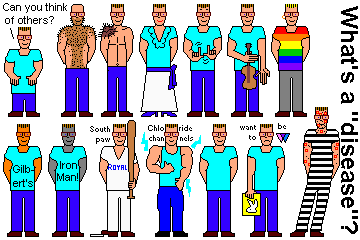 |
Top row: Achondroplasia (considered desirable in some cultures),
baldness-hirsutism (considered attractive or unattractive),
Becker's nevus, cross-dressing (stigma, unwanted compulsion, and/or
source of enjoyment), deafness (many deaf resent being called
handicapped, especially where sign language is widely spoken; this was
intensely politicized in the late 1990's as some "multiculturalists" /
"advocates for the deaf"
tried very hard to prevent young children from obtaining cochlear implants),
Ehlers-Danlos (the unusual joint structure may confer superior musical
ability, as with Paganini), homosexuality (once a "disease",
now mainstream) Bottom row: Gilbert's disease (an abnormal lab finding with no health consequences), hemochromatosis (fatal if neglected, but offers advantages), left-handedness (carries a tremendous stigma in some cultures, where the left-handed go to great lengths to conceal their "disease"), myotonia congenita, serial killer ("They look just like everybody else" -- Wednesday Addams), dissatisfied straight who'd like to be "bi" -- some adults are now asking psychiatrists for help with this (J. Homo. 15: 7, 1988), XYY "stereotype of the karyotype". |
Blake's "visions" and "voices" strongly suggest schizophrenia, and sometimes they terrified and baffled him. His contemporaries considered that Blake's "genius" and his "madness" (both of which were obvious) must be part of the same process. But even today, I don't think any reasonable person would consider Blake "diseased" or "disabled". In fact, there's now a considerable amount of talk about schizophrenia, which is a polygenic process with some environmental modification, being the result of natural selection for genes promoting human creativity (Proc. Biol. Sci. 22: 2801, 2009).
|  |
A DISEASE PROCESS is one of the generic mechanisms common to many diseases, i.e., inflammation, mutation, multiplication of infectious organisms, edema, thrombosis, and so forth. Alternatively, it can mean "pathogenesis". There is little reason to use the term "disease process". Especially, physicians don't say it when we mean "disease".
PATHOPHYSIOLOGY literally means "how physiology is altered by disease". If you know physiology, you can easily tell what is going to happen when you understand the pathogenesis of a disease. As a result, the term has a special meaning in medical education -- a course in disease that de-emphasizes pictures, taught by physicians who are not pathologists or surgeons. Usually it is run by internists.
The mind never thinks without a picture.
-- Aristotle
Over 30 years as a medical school teacher has taught me that the common request, "Teach us more pathophysiology!" really means "Teach us physiology." I'm always honored, and we can always review normal "fiz" in lab.
At allied health schools, "pathophysiology" is the term for the course on disease, almost always directed by non-physicians.
In trivial-untreatable non-disease, the mainstay of therapy is education coupled with a sense of humor. A bodybuilder friend went from hating to loving his Becker's nevus upon receiving my advice: "Tell people that's where a bear licked you". A man with morphea is "Linoleum Man"; a man with treated hemochromatosis sports an "Iron Man" shirt; a man with multiple small lipomas "was conceived during a campfire-marshmallow-toast"; "My birthmark is an erogenous zone"; "Vitiligo? You have to pay extra for a two-tone chassis"; etc., etc.
Science and opinion. The first produces knowledge. The second produces ignorance.
-- Hippocrates, "Laws of Healing"
PUBLIC HEALTH, i.e., studying what influences, and how we might better influence, the health of our communities, is a proper part of a meaningful pathology course. I will be blunt. And you SHOULD be upset.
If I simply say, "Iodine deficiency causes goiter and lots of people are sick from this", it makes the world's poor folk sound foolish or indifferent. They aren't.
If I blame the goiter-belts' corrupt, moronic and tyrannical politicians and screwball anti-everything activists, I am only telling the truth. There are not two sides to this business.
And the existence of widespread, crippling iodine, iron, and vitamin deficiencies in today's world OFFENDS ME much more than the truth should offend you, Doctor.
POVERTY, as used by social scientists, means a total income less than three times the cost of a varied, nutritious diet. ABSOLUTE POVERTY means total income less than the cost of a diet that will enable a person to work at maximum efficiency. PRESENTLY, ONE PERSON IN SEVEN LIVES IN ABSOLUTE POVERTY.
THE DEVELOPING WORLD is a euphemism for THE POOR NATIONS. "Resource-poor environments." The causes of world hunger are complex, but it seems both cruel and patronizing to say "the developing world" when some (not all) of these countries are actually deteriorating. I prefer not to use the term, though again, this may "offend" someone.
One objective of this course is to help you understand popular and media claims about health and disease. Now's a good time to offer some more definitions. You'll want to know these for talking with your friends (and adversaries!) These are mine, but they work:
SCIENCE: Trying to learn about the world systematically, taking elaborate precautions against deception (especially self-deception). Advancing knowledge by testing hypotheses and developing successful theories, grounded in looking at the world as it really is.
NATURE: The world of physics, chemistry, molecules, botany, zoology, astronomy, geology, human biology and pathobiology, the brain and its hard-wiring, the experiences and desires common to all human beings. Studied by the natural ("hard") sciences and general psychology.
THEORY: An idea about the world that has consistently enabled people to make successful predictions. The round earth, the periodic table, the structure of the atom, the circulation of the blood, the earth orbiting the sun, plate tectonics, the genetic code, the expanding universe, Darwin's common descent of living things, Feynmann's quantum electrodynamics. Newton's and Maxwell's physics was true until Einstein's relativity and Planck's quantum theory added greater predictive power, and there have been further improvements.
PROPAGATED ERROR: Ill-grounded speculation or erroneous data that gets passed from author to
author until it is ultimately corrected (and it will be). For several years after the first human
karyotype, biology textbooks copied an original miscount and described 48 human chromosomes.
Recently-corrected errors (each of which I called as such, years before their official correction)
include the mechanism of action of selenium dandruff shampoo,
herpes 8![]() cell proliferation being
cancer ("Kaposi's sarcoma"), the rarity of primary progressive tuberculosis
cell proliferation being
cancer ("Kaposi's sarcoma"), the rarity of primary progressive tuberculosis![]() ,
and the 1960's and
1970's unfortunate ideas about "sudden infant death syndrome". In my opinion, errors still in propagation
include end-of-the-nail splinter hemorrhages as a sign of endocarditis, and the initial passage through the lungs of
the deep cutaneous yeast infections. I will protect you from exam questions about these.
,
and the 1960's and
1970's unfortunate ideas about "sudden infant death syndrome". In my opinion, errors still in propagation
include end-of-the-nail splinter hemorrhages as a sign of endocarditis, and the initial passage through the lungs of
the deep cutaneous yeast infections. I will protect you from exam questions about these.
PSEUDOSCIENCE: Using the language and authority of science, without using its methods. Astrology, Freudian psychoanalysis, Marxism, medical quackery, creation-science / "intelligent design" (in contrast to the religious-ethical doctrine of creation), hypnotic memory-enhancement, "dianetics", facilitated communication for autism (i.e., using autistic kids like ouija-boards), anti-immunization activism, anti-fluoridation activism, "multiple chemical sensitivities", most "contemporary gender theory", most of the stuff about "race", many others. Pseudoscience is about politics and big money. Dealing with pseudoscientists is distasteful and can be dangerous. Because their target audience wants to feel intellectually and morally superior and will not examine the subject fairly, pseudoscientists launch vicious personal attacks at anyone who tries to argue with them. Point out obvious untruths, and the discussion immediately turns into "Okay, we lied. You're still the bad guy. Now let's hear you explain this one...."
JUNK SCIENCE is one step above pseudoscience. It's a term, mostly used by lawyers, for poor natural-science (old studies, bad studies, discredited studies; also statistics and tables out of context as in pseudoscience) used in arguments directed at the public or in court. Real work is cited accurately, but very selectively and misleadingly. Much of this is obviously intentional by agitprop writers who have no reason to tell the truth. Today's grown-ups are well-aware of this, and generally (and rightly) dismiss "new information about health risks" and "warnings of impending environmental catastrophes" as junk science. This is regrettable, since this prevents the public from taking some real dangers seriously.
SUB-SCIENCE: My term for disciplines that try to study areas of major human concern but in which the methods of science (measurement, experiments) are difficult to apply. Emotion and ideology come to dominate the practitioners, and since the sub-sciences have an enormous influence on politics, this is bad.
APHORISMS are prominent in the sub-sciences and pseudosciences. These are statements that one wouldn't think are true, but that distill the passionately-held personal impressions that people decide are true BEFORE the usual methods of science have been applied. Aphorists usually claim that those who do not agree with them are wicked.
No reasonable person questions that many cases of sexual assault go unreported. But the familiar statistic that FBI data shows that only 2% of reports of sexual assault are untrue was itself made up out of thin air by a widely-read militant. I'll let you find the facts yourself.
Even Virchow's dictum that "cancer cannot arise in an epithelium" (!!) remains a monument to the human capacity for self-deception. (Virchow did not consider those who disagreed with this aphorism to be wicked. But his mistake did lead to disaster.)
It's now well-established that people are more hesitant to say something isn't believable than that it is believable (i.e., we are born with open minds that it's fairly easy to fill with ____; Sci. Am. 298(3): May 2008). Of course I find that this psychological mechanism explains many other instances of intolerance too. You need to decide for yourself.
Why do smart people persist in believing stupid things? They seek out confirmation and support for their emotionally-held beliefs, and supplying these is an industry (Sci. Am. 287(3): 35, Sept. 2002).
Literary "theory" is a special case; the ideology at the beginning of the 21st century was still "il n'y a rien hors la texte", which is obviously not true, and what happened to college English departments was lamentable. The recent "postmodernism" fad, especially as represented in the works of Michel Foucault ("the era's greatest intellectual"), appears to me to rest upon confusing sub-science (and the harm it does) and real science (and the real knowledge it produces). I have never met or seen anything by a postmodernist or "social constructionist" who actually seemed to know any science.
CULTURE: Behaviors and attitudes that are not hard-wired into human beings, but are passed along from generation to generation to enable us to live together in relative peace, health, security, and satisfaction, instead of merely living the way that animals live. Studied by the other "soft" sciences and especially the sub-sciences.
THE CULTURE WAR: Probably as ancient as our species, the three-way struggle for control of human culture by the Left, the Right, and the naïve naturalists. The usual tactic is to present whoever doesn't want what you want as an unreasonable extremist of one of the other two categories.
IDEOLOGY: Any stupid-unreasonable-unscientific idea that some people believe passionately. In our world, the ideologies do enormous harm and little good. Followers of ideologies are IDEOLOGUES. (You may prefer "suckers", "ditto-heads", "dupes", "pride in ignorance", or any of the other synonyms.) Leaders of ideological movements get money and/or political power. Followers find companionship and feel intellectually and morally superior, and without having to be kind or decent to those around them. Typically ideologues mean well, and they leave the movement when, and only when, they find out they've been deceived intentionally. In my experience, every human being with a mental age of 12 or higher is interested either in science, or in one of the ideologies. I strongly recommend science, not ideology, to people with the responsibility of looking after other people's health and guiding public opinion. You can talk to me about it if you want.
POLITICS: How people work with and against each other to distribute limited opportunities and resources. Especially in health care and education nowadays, every dollar that a special interest group demands is a dollar taken from somebody else. The fact that everybody prefers to ignore this basic truth explains many of the characteristics of public debate.
RIGHT-WING (CONSERVATIVE) POLITICS: Honest, thinking conservatives focus on how wealth and opportunities are created and defended, rather than how they are distributed. Distinguish good, decent conservatives from right-wing ideologues (traditional anti-science-religionists, majority-culture racists-sexists-hatemongers, the anti-contraception crowd, the folks responsible for apartheid, today's pseudo-Christian mudslingers and pseudo-Islamic terrorists, etc.) Each of these ideologies is a public health problem.
Right-wing ideologues, being unreasonable and having their facts wrong, claim moral superiority and attack science and reason; almost without exception, they claim to be motivated by religious zeal. Right-wing ideologues portray honest, reasonable people as diabolic.
Good, decent conservatives look to science as the means to a higher standard of living, plus personal and national security. Think about it.
LEFT-WING (LIBERAL) POLITICS: Honest, thinking liberals focus on getting wealth and opportunities redistributed by the government, rather than creating or defending them. Distinguish good, decent liberals from left-wing ideologues (anti-science nature-mystics, minority-group racists-sexists-hatemongers, the "entitlement-rights-victims-political-correctness" crowd, the drug crowd, the animal-liberation folks, the magic-thinking brand of environmentalism, the folks responsible for communism, etc.) Each of these ideologies is a public health problem.
Good, decent liberals look to science as the means of ensuring a safe, clean environment, and the way to counter the ignorance and lies that form the underpinnings of prejudice and actual injustice. Think about it.
Left-wing ideologues, being unreasonable and having their facts wrong, claim moral superiority and attack science and reason; this is almost always in the name of the poor, the oppressed, the women, the minorities, and the alienated. ("Here is our critique of...") Left-wing ideologues portray honest, reasonable people as wicked oppressors of the helpless downtrodden.
Today's postmodernists take early-1900's psychiatry at its least scientific (which really WAS institutionalized pseudo-knowledge that often wrongly stigmatized and oppressed people) as the prototype of medicine. It seems to me that these people are wrong to apply their analysis of sub-science to genuine science and human reason.
Left-wing ideologues, who pretend to be "scientific", typically use the word THEORY when they mean "ideology". For the failure of "gender theory" to predict findings about sexual violence, see Violence & Victims 9: 95, 1994, Int. J. Law & Psych. 14: 47, 1991, the only two empirical studies on medline. The term "gender theory", once widely-used, has now vanished from the medical literature. The other favorite militant-Left term, "critique", is more of an admission that we're doing propaganda, not science.
RELIGION: Whatever people think deals with matters of ultimate concern. Various religions have varying contributions from science, ideology, secular philosophy, and revelation (whatever the latter is). Some definitions of religion would require some belief in the supernatural (i.e., causes outside the familiar subject-matter of science); other definitions would not. My own leap of faith begins... "I believe that love is not just a trick that my DNA plays on me to make more DNA."
Naïve naturalism (scientific reductionism): Two reasonable terms for the attitude (common but by no means the norm among scientists or those who admire science) that the extraordinary success of the natural sciences in adding to human knowledge and power means that human ideas about "the transcendent", "God", and so forth must be untrue.
Especially at high levels, scientists do tend to be much less likely to profess orthodox religion (i.e., to pray expecting results, and to believe in an afterlife): Sci. Am. 281(3): 88, Sept. 1999.
"The naturalistic fallacy", sometimes put forward by (and more often falsely attributed to) science-oriented people is this: "Because something happens this way in nature, therefore it should happen this way in human society."
The task of science, therefore, is not to attack the objects of faith, but to establish the limits beyond which knowledge cannot go and to found a unified self-consciousness within these limits.
-- Virchow
ETHICS: Trying to understand what we mean when we say "right" and "wrong", and why. Its real purpose in a pluralistic society like ours is to influence politics (i.e., trying to influence who gets what limited resources and opportunities by moral arguments, sometimes very selective). Private work in ethics, i.e., the hospital ethics committee, usually focuses on finding precedents and common-sense for defending yourself when you're trying to do the right thing and/or the expedient thing and protect yourself in the process. By contrast, public discussions of "ethics" are often (not always) as one-sided and unreasonable as those from the most intolerant and dogmatic religionists. As you already know, ideologues always present themselves as highly moral, and their opponents (scientific thinkers, ideologues of other camps) as evil, venal, and immoral. Science acting alone cannot tell you what's right or wrong, but the best way I know to end up making a bad decision is to pretend that the world is something that it isn't, i.e., to ignore scientific knowledge. And it's been my experience that this is where most (not all) public discussions of "ethics" are conducted -- in an atmosphere of make-believe and mud-slinging.
Great villains believe they're right.
-- Jean-Claude Van Damme, KC Star 12-23-95
Never underestimate the power of very stupid people in large groups.
-- Author unknown
When all think alike, then no one is thinking.
-- Author Unknown
The best lack all conviction, while the worst
Are full of passionate intensity.
-- Yeats
We thought, because we had power, we had wisdom.
-- Stephen Vincent Benet, "Litany for Dictatorships" (1935)
Mundus Vult Decipi.
The world wants to be deceived.
-- Latin Proverb (Martin Luther?)
It isn't what we don't know that gives us trouble, it's what we know that ain't so.
-- Will Rogers
Against stupidity, the gods themselves struggle in vain.
-- Schiller, "Maid of Orleans"
Believing is easier than thinking. Hence so many more believers than thinkers.
-- Bruce Calvert, mathematician
Opinions founded on prejudice are always sustained with the greatest violence.
-- Hebrew Proverb
A person about to speak the truth should keep one foot in the stirrup.
-- Mongolian Saying
The great enemy of the truth is very often not the lie -- deliberate, contrived, and dishonest -- but the myth -- persistent, persuasive, and unrealistic.
People don't want to be informed, they want to be entertained.
-- Jack Kennedy
-- Dan Matthews
Director of Campaigns for People for the Ethical Treatment of Animals
People Magazine, Feb 13, 1995;
HOAX: Deliberately falsified evidence, usually concerning something of grave importance, almost always targeting left-wingers or right-wingers. Important hoaxes in recent times include Carlos Castañeda's non-existent Yaqui sorcerers (he could not produce his field notes, acquaintances say he spent his time in the library reading books on shamanism, real Yaqui experts say they're obviously fake, and real Indians were outraged), the Paluxy River footprints "that proved humans lived at the same time with dinosaurs" (the creationists who carved the best ones confessed long ago, and this kind of fabrication is typical of classic "creation science"...), the Calavaras skull (a human skull supposedly found in very old strata; the "scientific source" for this often-cited "evidence for creation" is an old tabloid newspaper), the "Amityville Horror" fabrication (when the book wouldn't sell as horror-fiction, the author repackaged it as fact), Ferdinand Marcos's "gentle Tasaday tribe" (slum-dwellers transported to the jungle, talking their version of pig-Latin; the perpetrators targeted left-wingers who wanted to believe that a community could survive "in peace and harmony with nature" and without knowing how to fight, and the real anthropologists knew right away that it was a fraud because there was no "kitchen midden", i.e., no garbage dump), everything about Laetrile (right-wingers getting rich off other right-wingers), the popular books supposedly written by former members of powerful satanic cults ("Satan Seller" by Mike Warnke, "Michelle Remembers" by Michelle Smith, others; I'm pleased to note that these people were all exposed as fakes by their fellow-Evangelicals), Immanuel Velikovsky (didn't take college physics, and it shows), the Bermuda Triangle (Lawrence David Kusche took a year out of his life to examine the actual records of the supposed mysterious disappearances, and of course the accounts in the big-money books were massively falsified), and T. Lobsang Rampa's entire body of writings (when "the high Tibetan lama" turned out to be a Mr. Cyril Hoskin, the son of an English plumber, he claimed a "soul transplant" but could not read or speak a word of Tibetan). I would have liked to believe that Alex Haley had indeed miraculously traced his "roots" to Gambia, but the court proceedings brought out the sad truth about his elaborate, utterly cynical racial hoax. Sun films' documentary on the discovery of Noah's Ark (shown on TV in 1993) was the end-result of a skeptic's successful effort to demonstrate the lack of scientific standards at the most influential creationist organization; the "wood from the ark" was store-bought lumber steeped and boiled in teriyaki sauce, and a sniff would have been enough to reveal the hoax (let alone some honest tests on the wood). The famous "multiple-personality disorder" patient "Sibyl" was shown in 1998 to have been induced under hypnosis after a psychologist reviewed audiotapes between the therapist and the book author. The book helped cause the disastrous "repressed memories" fiasco of the 1980's to mid-1990's, which ended with tens of thousands of ruined families and huge successful legal judgments against therapists who had induced false memories. Fox TV's 2001 piece on the moon landings being faked was itself a masterpiece of bunko artistry (how it was done: Sci. Am. June 2001). During the 2005 "Intelligent Design" trial, Michael Behe, the only scientist who ended up willing to testify under oath, admitted under cross-examination that he knew that his claim about the "irreducible complexity" of the clotting cascade was a lie. "Historical revisionism" (holocaust-denial), crackpot biology (left-wing, right-wing), and most of the Kennedy assassination conspiracy theories are built on lesser hoaxes (along with fallacies and personality smears, of course). Scientists are much harder to fool, and in spite of what you've been told, most didn't make much of "Piltdown man" even decades ago. As physicians, you need to be able to recognize hoaxes, preferably before they are exposed. Your patients will ask you about them.
The impact of disease on humankind is tremendous. The subject is never "just academic". Each of us will have some first-hand experience with the content of a "pathology" course.
The citizens of today's western democracies are the healthiest humans who have ever lived. This is due almost entirely to the knowledge, technology, and improved standard of living produced by the much-maligned "dominant culture" characterized (at its best) by an emphasis on science, personal liberty, democratic government, free enterprise, and the work ethic. Contrary to what you may have been told (by "liberals", "greens", or "conservatives"; some of the latter still lie about the "healthy Hunza people of the far Himalayas"), we are far healthier than "indigenous peoples", past or present (pull up "indigenous people / tribes / tribal" on the medline if you don't believe me).
* Something's just not right -- our air is clean, our water is pure, we all get plenty of exercise, everything we eat is organic and free-range, and yet nobody lives past thirty.
-- Two cave men
New Yorker cartoon, 2006
In the 1990's, we heard a tremendous amount about "cultural relativism" and "multiculturalism." Your lecturer (who gives his race as "human" and thinks everybody should do the same) appreciates multiculturalism, or what is left of it, so long as its proponents are understanders, peacemakers and enrichers (like in their rhetoric).
Multiculturalists begin by observing how human attitudes and behaviors differ from culture to culture. Ideological multiculturalism jumps to the conclusion that ALL of our beliefs and behaviors are culturally determined. This is contrary to common sense, common experience, and a large body of empirical evidence from field anthropologists about what all human cultures have in common. The benign ones include trying to appease divine beings, having fashions in hair styles, having group sing-alongs, seeking privacy for toilet functions, and (I've been told) the nyah-nyah tune with which children taunt a hapless peer. And despite your lecturer's admiration for humankind in all our rich diversity((he hopes you will REJECT the a priori claim that "You should not judge another's cultural practice or belief about the world." (Nowadays, new moral imperatives are a dime a dozen, and they can't all be right.) You may find this articulated on college campuses, though not much in the hard sciences. I have noticed that since 9/11/01, the movement off-campus seems to have ended.
Today, the word "multicultural" in an article by and for physicians is usually is a euphemism for "multiracial" / "multiethnic", while the word "multiculturalism" has nearly vanished except in lists of supposed professional virtues (Acad. Med. 80: 366, 2005). Martin Luther King's dream was of a colorblind America, and today most people who are really trying to reduce racial prejudice try to de-emphasize categories and focus on what we all have in common (J. Pers. Soc. Psych. 78: 635, 2000). How the "multiculturalism" collapsed in the democracies without even the Left being unhappy: Br. J. Soc. 55: 237, 2004 ("inherent deficits and failures of multiculturalism policies, especially in socio-economic respect...")
As a physician, you'll do well to learn something about the idiosyncrasies of ethnic groups, especially those that may impact on how you communicate with each other and whether they comply with your instructions. Presumably you're already a good enough listener and human being to respect what people tell you they want. Even the sociologists and anthropologists (the disciplines most famous for radical multiculturalism) now tell physicians, "Engaging with other cultures does not imply that all cultural norms should be accepted uncritically, as there may not always be room for compromise" (no kidding; Med. J. Aust. 176: 174, 2002). When Yale (not a bastion of social conservatism) teaches multiculturalism to its medical students, they just hear about what communications styles and techniques might work best, and about possible attitudes toward disease that might help or hinder therapy (Acad. Med. 72: 428, 1997). It tremendously important to speak charitably (and not show anger or frustration)about others' "cultural" practices and ideas that "may seem backward to you." Today's accrediting agencies require medical schools to teach "cultural competency" and exactly how to do this is emotionally and politically charged and dangerous (UC Davis, Acad. Med. 83: 651, 2008.) Despite laments that most medical schools do not have "separate courses addressing cultural issues" (Acad. Med. 75: 451, 2000), I would not want to see a medical school teacher stand up and say "You need to know that ____ people believe ____, ____, ____, and ____, and they do ____, ____, ____, and ____, so as a doctor you must ____, _____, ____, and ____ with them."
Actually looking at the influence of "culture" on health and disease does not always show humankind at its best. ____ men object vehemently to their wives doing breast self-exam. If a man of the _____ culture fails economically, his family discards him. ____ intravenous drug-users generally refuse to use condoms. In the country of ____, the active partner in a homosexual relationship is perfectly acceptable, while the passive partner is a social outcast. In modern industrial nation of ____, there has never been an organ transplant surgery simply because people don't care about people they don't know. "In [the country of] ___, young people who suspect they may be infected with HIV will avoid a definite diagnosis while at the same time seek to spread the infection as widely as possible." And so on. See JAMA 285: 1075, 2001; Med. Anthro. 17: 363, 1997; many others. And if "all cultures are of equal value" or "you cannot judge another culture", how can we talk about our own civilization having made moral progress over the years, say by banning slavery or by giving women the vote?
One more note for health-care providers interested in the "multiculturalism" business: Don't fall into the trap of telling someone else, "You are of thus-and-such culture, therefore you are/want/believe thus-and-so." You will end up looking as foolish as the physician who was forced to disclaim, "All persons must be treated as individuals first, not as stereotyped members of a cultural group" (West. J. Med. 158: 201, 1993 for the not-at-all-funny story). I note with pleasure that even the ideologically-minded nurses are now repudiating ideological multiculturalism in favor of truth and common sense (Nurs. Inquiry 3: 3, 1996; J. Adv. Nurs. 23: 564, 1996; J. Prof. Nurs. 12: 159, 1996; the latter prefers "a transcultural ethics grounded in moderate realism"). Most recently, medical students overwhelmingly reject the sort of "cultural sensitivity training" that plays politics and/or pigeonholes people (article contains euphemisms: Acad. Med. 78: 1191, 2003).
The improvement of medicine will eventually prolong human life, but the improvement of social conditions can achieve this result more rapidly and more successfully.
-- Virchow
Following Rudolf Virchow's lead, your lecturer believes that GOOD HEALTH IS A FUNDAMENTAL VALUE BASIC TO ALL OF HUMANKIND, and therefore hopes you will reject supposed "cultural values" that will predictably lead to impaired function / poor health (my list, closely modelled on Dr. Virchow's work):
These world-level political-social problems are the over-riding causes of both ill-health and general misery on our planet. No "culture" (or any other group) has a monopoly on good or evil; but the next time someone tells you that "All cultures are of equal value", compare the number of people trying to enter, and trying to escape from, the U.S., Canada, and Western Europe. Then be grateful.
To clarify: I know no secular meaning for the word "value" except as a statement of what real-life people want. "Multiculturalism" or no, "values clarification" or no, really get to know your neighbor "across cultural lines" and you'll almost always meet someone who wants the same things you do. These begin with good health, economic opportunity, personal self-determination, and respect. Etiquette and buzz-words differ among ethnic groups, and a good physician learns to avoid misunderstandings.
Your lecturer first placed these thoughts online in 1994. They are echoed especially in Ruth Macklin's "Against Relativism: Cultural Diversity and the Search for Ethical Universals in Medicine". Prof. Macklin comes up with pretty much the same ideas as your instructor: humaneness (i.e., being healthy rather than in pain) and humanity (i.e., having others allow you to choose your own path). See also Health Care Analysis 8: 321, 2000; Soc. Sci. Med. 60: 1347, 2005 (the author in this traditionally far-left wing journal says, "Get them healthy and just claim you're not interfering with their 'culture'").

|
THE TESTABLE STUFF ON THIS HANDOUT STARTS HERE. Scientific, evidence-based medicine is based around the concept of discrete diseases. This is the approach that works. In today's world, only the charlatans and the fools deny that there are many distinct, identifiable diseases with varying causes, or complain that studying disease objectively makes physicians care less about "whole persons".
The most recent diatribe against the "disease model" is really just about overtreatment (Am. J. Med. 116: 179 & 186, 2004).
There is a "pop" claim that "fifty percent (or however much) of what you learn in medical school is proven wrong within ten (or however many) years." This just isn't true. Look at John McCrae's hundred-year-old textbook of pathology, or William Osler's book of internal medicine, or Vesalius' anatomy books. We know much more, best-treatment protocols change, but there are very few true errors.
However, THERE ARE ONLY A HANDFUL OF UNDERLYING MECHANISMS OF DISEASE (the "disease processes"). The body responds to life's hazards in stereotyped ways. These are the subject matter of GENERAL PATHOLOGY (i.e., the stuff up through "Neoplasia/Infections/Immunopathology/Fluid-Hemodynamic"). You'll need to remember them well; they are the template onto which you will place your knowledge of disease.
In contrast to general pathology, SYSTEMIC PATHOLOGY concerns itself with specific diseases that involve the various organ systems. You can use your general pathology knowledge to predict the contents of a chapter in systemic pathology. ANATOMIC PATHOLOGY is the business of making diagnoses by examining tissues, while CLINICAL PATHOLOGY is concerned with the rest of the things done by the clinical lab, i.e., blood banking, clinical hematology, clinical chemistry, clinical microbiology and maybe molecular pathology. FORENSIC PATHOLOGY is a subspecialty under anatomic pathology, dealing with medicolegal issues, especially questionable deaths.
|
|
A BIOPSY is tissue removed from a person during life and that will be sent to the pathologist for diagnosis. A rotten tooth or an ingrown toenail will not be sent for diagnosis; most other tissues, including resections where the diagnosis is already made, will be sent and hence are biopsies.
OPEN BIOPSY means an incision was made to obtain a larger mass of tissue.
INCISIONAL BIOPSY means that a piece of tissue was taken for diagnosis from a larger structure that is diseased.
EXCISIONAL BIOPSY means the mass or entire organ was removed for diagnosis and perhaps cure as well.
AUTOPSY ("necropsy") is the opposite of "biopsy". The pathologist examines part or all of a dead body.
The folks at Arkansas found that in 125 autopsies, there were 47 class I's ("missed major diagnoses that, if detected before death, could have led to a change in management that might have resulted in cure or prolonged survival") and 34 class II's (same but wouldn't have led to a change in management). I am not making this up. Arch. Path. Lab. Med. 126: 442, 2002.
* Future pathologists (and future users of pathologist services): These are the most common "problem" biopsies as judged by litigation! Am. J. Surg. Path. 18: 821, 1994
If you've been brought up on "pop" ideas about health and disease, you'll be surprised by how little you hear in this course about "imbalances", "buildup of poisons", "poor circulation", or "vital forces". This is the emphasis of folklore, not today's science. But you may find these folk-terms helpful in explaining things to patients from various backgrounds.
SYMPTOMS are, of course, the patient's subjective observations, while SIGNS are evidence of disease discovered by the physician. Unless otherwise qualified, "signs" are abnormalities on physical exam, and FINDINGS are physical, lab or x-ray results. LESIONS are fundamental pathologic changes (usually anatomic derangements, though they may be molecular) that the pathologist can exhibit.
A SYNDROME is a cluster of related symptoms and/or signs not necessarily due to the same causes in different patients, but typically due to a single cause in any individual patient. Your understanding of basic anatomy, biochemistry, and physiology can help you understand the various syndromes. A DIATHESIS is a condition that interferes with normal response to minor hazards of daily living. (The usual use of this odd word is "bleeding diathesis", i.e., the patients are fine until they need to clot their blood.)
The ETIOLOGY of a disease is its "cause", and "Big Robbins" begins with an important point:
IT IS SIMPLISTIC TO THINK OF AN INDIVIDUAL DISEASE HAVING A SINGLE "CAUSE".
For example, you could
consider the "cause of fatal measles![]() in poor countries" to be the measles virus, the malnutrition
that makes the infection more severe, the poverty and crowding in which the infection flourishes,
or the local laws that forbid immunization.
in poor countries" to be the measles virus, the malnutrition
that makes the infection more severe, the poverty and crowding in which the infection flourishes,
or the local laws that forbid immunization.
INTRINSIC ETIOLOGY means the genetic component of any disease. Although the human genome is now sequenced, it is not always clear how a particular mutation leads to a particular disease.
EXTRINSIC ETIOLOGY is everything else -- bugs, physical injury, poisons, bad nutrition, lots more
* Actually, can you think of anything with a single cause? The Buddha, attending an autopsy,
reportedly philosophized, "He died because he was born." If you are interested in quackery, you
will hear the following fallacy: "Since some people carry
staphylococci![]() or pneumococci without
becoming sick, microorganisms do not really cause any disease, and immunizations and antibiotics
are useless." A lie -- how would you answer it?
or pneumococci without
becoming sick, microorganisms do not really cause any disease, and immunizations and antibiotics
are useless." A lie -- how would you answer it?
The closest we come to "single etiologies" is the one-gene disorders
and the extreme virulent infections (measles![]() , rabies
, rabies![]() ,
ebola
,
ebola![]() ,
influenza
,
influenza![]() ).
).
In court, I am likely to be asked, "To a reasonable medical certainty, did the patient's exposure to substance A cause disease B?" The requirement is "more likely than not", and the best way to demonstrate it is that people exposed to substance A have MORE THAN TWICE THE RISK than do unexposed people of getting disease B. Of course, you've got to control for everything else, including other variables, selection bias, and recall bias. Good luck. Note in particular that, as of right now, breast implants have not met this test for any known disease.
The PATHOGENESIS of a disease is the sequence of events at the organ, cellular, ultrastructural, and molecular levels, by which the disease develops. The story -- from etiology to symptoms and signs -- is always complicated.
By convention, a PATHOGEN is a micro-organism that causes disease.
MORPHOLOGY / MORPHOLOGIC CHANGES / MORPHOLOGIC DERANGEMENTS is whatever the pathologist can exhibit grossly or under the microscope.
PATHOGNOMONIC is a big word that means that a particular abnormality is found only in one condition. ("Hearing the fetal heart tone is pathognomonic of pregnancy." "Finding a Reinke crystalloid in a primary benign testicular tumor is pathognomonic of Leydig cell adenoma.")
By contrast, a FORME FRUSTE of a disease is a very mild variant, that may teach us about the more serious malady.
ORGANIC DISEASE has a clear anatomic and/or chemical lesion, while FUNCTIONAL DISEASE has not (yet?) yielded its deep secrets and is assumed to result from subtle nervous system abnormalities and/or mild mechanical problems. Pathologists seldom talk about "the functional diseases", i.e., don't expect us to talk about migraine or low back pain with the same zeal as we discuss sickle cell anemia.
The INCIDENCE of a disease is the number of new cases per unit time (usually given as "new cases per 100,000 people per year"). The PREVALENCE of a disease tells how many people are affected at any one time (typically, "cases per 100,000 people"). Obviously, prevalence equals incidence times average duration. "Rare" means that fewer than 1 person in 2000 will get a particular disease during the lifetime.
The RISK of a disease is how much your unusual situation (typically some kind of exposure to an uncommon hazard) increases your chance of getting the disease compared with everybody else. "Relative risk" has nothing to do with whether something is common or rare, mild or severe.
The DIAGNOSIS is the name given to the particular disease, once it is identified. The PROGNOSIS of a disease is the expected outcome for a particular case. "Good prognosis" suggests that recovery is likely; "poor prognosis" suggests permanent disability or death. The prognosis is likely to be influenced by the diagnosis, the age and general health of the patient, and the available treatments.
The best way to learn non-technical vocabulary words is to use them in a few sentences and have your guide say whether you're using them correctly.
WHAT HURTS CELLS?
This unit deals with ways in which cells are injured, how they look, and how they adapt to different conditions. We will deal with the interesting accumulations and deposits seen in and among cells in a later lecture. If you want to understand disease (and that's why we'll call you "doctor"), this unit is absolutely essential.
NECROSIS is the death of cells prior to the death of the organism, and its visible (grossly and/or microscopically) evidence.
* The law of nature is "adapt or die", but we can only offer qualified support to "Big Robbins"'s idea that "adaptation, reversible injury, and cell death should be considered states along a continuum of progressive encroachment on the cell's normal function and structure." Once accepted, this idea would place sports training on a continuum with flesh wounds.
* In classical pathology, we pay little attention to such adaptive (or maladaptive) phenomena as "up-regulation of surface receptors". Traditionally, we have left the study of these things to physiologists and pharmacologists. Remember that such cell adaptations are invisible by light microscopy.
HYPOXIA, or loss of the ability to carry on sufficient aerobic oxidative respiration, is the most common cause of cell injury and death. It is still the prototype.
THE CAUSES OF HYPOXIA:
ISCHEMIA ("ischemic hypoxia"; "stagnant hypoxia"): Loss of arterial blood flow (* literally, "holding back the blood")
Local causes
Systemic causes
HYPOXEMIA: Too little available oxygen in the blood
Oxygen problems ("hypoxic hypoxia")
Hemoglobin problems ("anemic hypoxia")
FAILURE OF THE CYTOCHROMES ("histotoxic hypoxia")
Cyanide and carbon monoxide poisonings
Dinitrophenol poisoning
Other curious poisons
{07447} carbon monoxide suicide; notice cherry-red color; the blackening of the lips is drying, and the epidermis has slipped off the chin; both indicate a post-mortem interval of a few days.
* NOTE: The best definitions of "hypoxia" (literally, "low oxygen") are broad enough to include all causes of inadequate oxidative phosphorylation, as above. Yeah, some textbooks limit "hypoxia" to "too little oxygen in the tissues", and I won't count this wrong, as long as you say "tissues" and not just "blood" (that's hypoxemia). Gee whiz.
Of course, increased metabolic demands (exercise, fever) will exacerbate any of these problems. It is rare, however, for anything more than temporary organ failure to result.
Despite the great importance of hypoxic injury, it is not self-evident why cells should actually die just because they cannot carry on aerobic respiration. See below.
Neurons undergo frank necrosis after being deprived of oxygen for 3-5 minutes at normal temperature (and clinically, brain damage follows much shorter intervals).
Heart muscle cells can last maybe 30-60 minutes.
Liver cells and renal tubular cells can last for 1-2 hours without oxygen before they are irreversibly damaged (and of course, they're easier to replace.)
A leg can last for many hours.
POOR NUTRITION affects cells as it does people. Different cells react differently to starvation conditions. Lack of glucose, for example, produces the same brain damage as does hypoxia. Other cells simply waste away and die.
INFECTIOUS AGENTS injure cells in a variety of ways. We'll study these under "Infectious Disease". Certain clostridia, for example, produce phospholipase enzymes that break down cell membranes and enable the bacteria to flourish briefly in dead tissue. Viruses and some rickettsiae explode cells when they multiply. Other kinds of harm are far more subtle.
IMMUNE INJURY (i.e., antibody or T-cell mediated) is of four or five enumerated types, which you'll learn soon. Curiously, "Big Robbins" does not list damage to the body's own "innocent bystanders", which routinely occurs in serious inflammation, even when lymphocyte-mediated immunity is not involved. Much more about this later.
CHEMICAL AGENTS (noxious stuff, or even "too much of a good thing" like water or salts) and PHYSICAL AGENTS including fire, freezing, electricity, barotrauma, and ionizing radiation (JAMA 266: 698, 1991), are less subtle causes of cell injury.
{01909} radiation necrosis of the brain (Think: this must be toxic/metabolic rather than traumatic or vascular, since you can see that it limits itself to one particular tissue type, the white matter)
GLUTAMATE EXCITOTOXICITY is a well-establlished cause of the death of individual neurons, in the "neurodegenerative diseases". Stay tuned; there's even a drug (riluzole) to slow it down (NEJM 330: 585, 1994).
For some reason, "Big Robbins" has also listed GENETIC ERRORS as causes of cell injury, rather than the results of injury to nucleic acids. Frequently, though, a cell that cannot metabolize something will accumulate preposterous amounts of the substance and eventually may die from it.
Obviously, cell systems for maintaining membranes, metabolism, enzyme synthesis, and gene preservation are inter-linked, and whatever affects one will affect the other. And of course, different cells (types, sick or healthy) will respond differently to adversity. Damage that is obvious microscopically is well-advanced.
HYPOXIC INJURY
|
In HYPOXIC INJURY, the sequence of cell injury and death is still yielding up its secrets.
The first change, of course, is loss of ATP production by mitochondria. Cellular ATP content drops rapidly and work stops. (For example, a heart muscle fiber stops beating within 60 seconds after cessation of blood flow). The lethal chain of events probably begins with the switch to inefficient anaerobic metabolism. The increased amount of AMP (from un-recycled ATP) stimulates anaerobic glycolysis (* AMP activates phosphofructokinase -- what's the teleology?), glycogen is depleted, lactic acid (the end-product of glycolysis) and phosphorus (from the ATP and other energy-rich phosphates) accumulates, and cell pH drops precipitously, denaturing the proteins. * Bio-philosophers: We could probably have avoided this process had we been designed to simply shut our cells down when the oxygen supply becomes low. However, this would have made it impossible to rescue ourselves from critical situations. |

|
When the cell goes anaerobic, one of the first changes is that the cell membrane loses the ability to keep sodium and water from diffusing in.
The increased permeability to sodium will turn out to be of extreme importance when we study the mechanism of rhythm disturbances when heart cells are deprived of oxygen.
Probably there is some hydrolysis of macromolecules right away, and this increases the osmotic pull.
Anyway, when hypoxia gets bad but cell isn't necessarily dead, ACUTE CELULAR SWELLING ("CELLULAR EDEMA") occurs. Much of this fluid is in the endoplasmic reticulum, and this is seen as dilatation on electron microscopy.
After a while, potassium starts leaking out. And then, calcium starts leaking in -- and this is bad. See below.
Enzymes begin to leak from the cytoplasm into the bloodstream (see below). Trypan blue, the marker for injured (not necessarily "dead") cells, will leak in.
All these changes have taken place in your skeletal muscles when you have exercised near your limit.
* I hope the fad word "oncosis", mentioned in Robbins, never catches on as a term for acute cell swelling.
* Fun to know: Among the most-conserved proteins over evolution are the "heat shock proteins", which refold denatured proteins and get rid of those that cannot be salvaged. The prototypes are ubiquitin and the chaperonins (the Hsp family). Whenever a cell is damaged, levels of these proteins increase strikingly. Right now the whole family is "proteins in search of a disease"; there are some interesting links.
Next, ribosomes start coming detached from the rough endoplasmic reticulum. "Big Robbins"'s observation that "polysomes dissociate into monosomes" is just another way of saying that RNA translation stops. Microvilli (if any) flatten, blebs form on the cell surface, and the membranes of disrupted organelles form laminated figures ("myelin-like", alternating layers of water and lipid formed from phosphlipid) in the injured cytoplasm.
{17369} laminated "myelin figures" in cell injury; electron micrograph ("mb"="myelin bodies") (NOTE: despite what anyone else may tell you, these do not prove that the cell is injured irreversibly)
|
|
At this stage, chromatin clumping and nucleolar scrambling are visible by electron microscopy, but not really by light microscopy.
Up through this point, all the changes are REVERSIBLE if oxidative phosphorylation is restored. One undeniable marker for early IRREVERSIBLE HYPOXIC INJURY is "calcification of the mitochondria". The mitochondria become permeable to calcium ("the mitochondrial permeability transition, other stuff gets in and out as well), which precipitates with the local phosphates (ADP & ATP, remember?) as an insoluble "amorphous density". This shuts them down permanently.
{17366} calcium precipitate within mitochondria
If you're interested in mechanisms of cell injury, pay attention to calcium as the likely mediator of irreversibility. Ordinarily there is almost no calcium inside a cell, and when it enters, it precipitates with phosphates (especially in mitochondria), releases phospholipases that destroy membranes, activates endonuclease that destroy DNA, activates caspases that start apoptosis, opens the mitochondrial pores, and does other things that are still being discovered. More generally, hypoxic injury (with the drop in pH and perhaps other reasons) allows "escape of sequestered calcium into the cytosol" (and surely also across the cell membrane from outside). Calcium is currently blamed for activating endogenous phospholipases (which damage membranes) and activating proteases (notably the "calpains", which wreck the cytoskeleton and which can be inhibited; Proc. Nat. Acad. Sci. 88: 7233, 1991) which damage diverse elements of the cytoskeleton. Remember you also need ATP to continue the synthesis of membrane phospholipids; swelling of the cell might rip the cytoskeleton off the membranes, damaging them; etc., etc.
The classic accounts of reversible and irreversible cell injury have been enhanced in 21st century by study of MITOCHONDRIAL INJURY, especially in hypoxic-ischemic and toxic injury. Here's what's known:
RIGOR MORTIS, following death, results when ATP is depleted and (I suspect) enough calcium has diffused into the damaged cells to make the sarcomeres clamp shut for the last time. (Remember that it's entry of calcium that makes sarcomeres contract in life.)
Around this time, the lysosomes also rupture and begin digesting the cell (with their DNAases, RNAases, proteases, phosphatases, sulfatases, glucosidases, and cathepsins, enumerated in "Big Robbins"). Obviously, once the genes have been sliced to bits, the damage is irreversible.
{17368} break in cell membrane, irreversible injury
{17374} nuclear pyknosis (arrows); be sure you can tell
a pyknotic nucleus from a live lymphocyte nucleus
{17379} dead renal tubular epithelial cells (within lumen of live tubule)
|
|
|
In the 1990's, there was considerable interest in free radicals (especially toxic oxygen radicals; see below) as mediators of REPERFUSION INJURY, i.e., additional harmful things that occur only when blood flow is restored to a damaged organ (still some interest: J. Neurosurg. 93: 99, 2000). Further, when blood flow is restored to damaged cells, the newly-available calcium will pour through the damaged cell membranes and into the mitochondria, killing the cells even faster. And later, the neutrophils, which fight disease using free radicals, accumulate at sites of tissue injury. Of course, if blood flow is not restored, the tissues will die anyway.
Finally, once cell membranes are badly broken down, certain lipids act as detergents, further disrupting the devastated cell.
NOTE: According to "Big Robbins", enzymes leak from the cell only when irreversible injury has occurred. This is clearly wrong; mild reversible injury is quite sufficient to cause enzyme leakage. These are the "liver enzymes", "cardiac enzymes", etc., that your lab measures to let you determine the presence and extent of injury in the clinical setting. (Skeletal muscle enzymes rise after a workout, and liver enzymes after a beer party, but in neither case is there microscopic or clinical evidence of cell death. By contrast, troponin I and troponin T are released from heart cells only when irreversibly injured.)
FREE RADICALS
A common "final pathway" in a variety of forms of cell injury, including injury brought about by inflammatory cells, is generation of free radicals, i.e., molecular species with a single unpaired electron available in an outer orbital. Single free radicals initiate chain reactions that destroy large numbers of organic molecules.
Notable results of free-radical generation:
1. Oxidation of unsaturated fatty acids in membranes ("lipid peroxidation", etc.) * Basic biologists: These are the same reactions that make unsaturated fats turn rancid.
2. Cross-linking of sulfhydryl groups of proteins.
3. Genetic mutations.
Free radicals may be generated in the following ways:
1. By absorbing radiant energy (UV, x-rays; striking water, these generate a hydrogen atom and a hydroxyl radical; when hydrogen peroxide contacts ferrous iron, it is cleaved into two hydroxyl radicals (* the Fenton reaction).
2. As part of normal metabolism (for example, xanthine oxidase and the P450 systems generate superoxide; our white cells use free radicals to attack and kill invaders)
3. As part of the metabolism of drugs and poisons (the most famous being CCl3.-, from carbon tetrachloride; even O2 in high concentrations generates enough free radicals to gravely injure the lungs).
The most important free radicals are probably those derived from oxygen, i.e., superoxide (O.-2) and hydroxyl radical (OH.); hydrogen peroxide, though not a free radical, is two hydroxyl radicals joined.
Lately we've also come to recognize the importance of nitric oxide in tissues; despite its popularity with viagra users, it's a free radical and generates even meaner free radicals (peroxinitrite, ONOO.).
We have only a limited ability to dispose of free radicals.
Certain molecules ("antioxidants") scavenge free radicals. Worth remembering are vitamin E, sulfhydryl compounds ("Big Robbins" list cysteine and glutathione, as well as the drug penicillamine), ascorbic acid (vitamin C; Ann. Int. Med. 114: 909, 1991), melatonin (Science News 114: 109, 1993) and the metalloproteins ceruloplasmin and transferrin. All except the drugs are "endogenous antioxidants".
Superoxide is ordinarily detoxified by superoxide dismutase into H2O2. (* This protein is sold as youth preservative pills, creams, and stuff. What's the fallacy?)
Catalase (in our peroxisomes, remember?) helps us by turning H2O2 into oxygen and water.
Glutathione peroxidase (a selenium-based enzyme -- * ask several health food store proprietors whether selenium is "very good for you" or "very bad for you") greatly speeds the consumption of free radicals by cross-linking sulfhydryl groups.
Whether or not you believe that free radicals explain aging, there is no doubt that they are responsible for many of the genetic mutations that cause cancer and birth defects.
For your future reference: When a free radical chain reaction scrambles two C=C double bonds on adjacent unsaturated membrane lipids, the resulting cross-linked mess is biologically inert and will stay around forever, eventually being incorporated into the wear-and-tear pigment "lipofuscin". This pigment also contains other un-digestible remnants. More about this later.
* Malondialdehyde in the urine is a traditional research measure of the extent of current whole-body free radical production. It's considered a pretty good marker for "increased oxidative damage" and is now being measured locally (for example, Neurology 64: 1152, 2005). Part of the problem is that it's also a normal by-product of prostaglandin metabolism.
* Burning fat by exercising generates free radicals. If you're physically fit, you produce fewer free radicals when you exercise because you burn fats more efficiently: Am. J. Med. Sci. 317: 295, 1999. If your heart's failing and you try to exercise, you produce more free radicals (Am. Heart J. 135: 115, 1998). And so forth.
CHEMICAL INJURY
Biological molecules react like any other chemicals. Acids and alkalies hydrolyze membranes, and horrible poisons like mercuric ion tie up sulfhydryl groups and ruin the cell. Formalin / formaldehyde crosslink amino groups on proteins and nucleic acids.
Other classic poisons affect the more vulnerable parts of the cells, depending on the poison and dose, there may or may not be necrosis:
Current thinking is that most simple nonmetallic poisons that don't totally disrupt mitochondria or ribosomes but that cause actual cell necrosis require activation to form free radicals. For example, carbon tetrachloride (old-fashioned cleaning fluid) is turned into CCl3.- radical in the smooth endoplasmic reticulum of the liver. Not surprisingly, the liver is damaged first, as described in detail in "Big Robbins".
{07020} carbon tetrachloride toxicity to liver,
gross (widespread cell death shows as yellow, in the centers of the lobules)
{07022} carbon tetrachloride toxicity to liver, microscopic (widespread hepatocyte loss;
note the paler centrilobular
areas where nothing is left except hepatic endothelial cells)
Chemical injury fades into other types of biological injury in certain PROTEASE VENOMS (pit viper poison, necrosis following a brown recluse spider bite).
{10658} snake and snake-bit foot
![]() Fer-de-lance snakebite
Fer-de-lance snakebite
Tissue necrosis
Wikimedia Commons
VIRUS-INDUCED CELL INJURY
CYTOLYTIC VIRUSES destroy cells, while CYTOPATHIC VIRUSES alter their morphology without causing necrosis. Viruses may also be produced by cells without any morphologic changes.
Viruses may kill a cell by scrambling the genes it needs to maintain its structure, or by multiplying so fast that the cell explodes. Obviously, it is not really in the virus's interest to kill its host organism.
Cold viruses may scramble cilia, and pox viruses scramble cellular vimentin. Most interesting are
the "giant cells" that result when several virus-infected cells fuse.
VIRAL INCLUSION BODIES![]() are
crystalloids of viruses in the nucleus and/or cytoplasm.
are
crystalloids of viruses in the nucleus and/or cytoplasm.
Further, the body's T-cells often attack cells that harbor viruses. For example, the cell damage in hepatitis B is brought about more by the T-cell patrol than by the viruses.
LIGHT MICROSCOPY OF CELL INJURY
The electron microscopic appearances of hurt cells described in "Big Robbins" reiterate the mechanisms of cell injury. We rarely use electron microscopy in diagnostic pathology, but we often examine cells.
REVERSIBLE CELL INJURY has two morphologic hallmarks -- cell swelling and fatty change.
CELL SWELLING ("cloudy swelling"; the extreme forms are called "vacuolar degeneration" or "hydropic change") is the visible change resulting from water being pulled by osmosis through damaged cell membranes.
It is subtle, it does not alter cell shape much, and we will not expect students to spot it. "Big Robbins" notes that organs with extensive hydropic swelling will be heavy.
Good places to look for "cell swelling" include the renal tubules of patients on diuretics, and the subendocardial myocardium of patients who died after hypotension of at least a few hours duration. (Why?) The epidermal "balloon cells" of acute contact dermatitis are another good illustration. Future pathologists: You'll use stains to distinguish "hydropic change" and glycogen accumulation in heart and kidney.
{19358} hydropic change in epidermis in acute contact dermatitis (perhaps poison ivy)
![]() Hydropic change
Hydropic change
Urbana Atlas of Pathology
FATTY CHANGE occurs when cells that ordinarily take up a lot of lipid (heart, liver) cannot process it. A weekend drinker's liver is only the best-known example. More about this later.
{08357} fatty liver, gross (yellow, felt greasy; you
would want to see the histology to make sure of the diagnosis)
{38782} fatty change in hepatocytes, oil red O stain;
note that
lipid vacuoles, being hydrophobic, are sharply demarcated from
the rest of the cytoplasm
NECROSIS is the gross and light-microscopic appearances that indicate cell death. "Big Robbins" gives two similar definitions back-to-back. (Purists will note that "necrosis" actually occurs only after death. Every cell on a microscopic slide is dead, but that only the necrotic ones were assuredly dead when the fixative froze their appearances in time.)
Nuclear changes are the light microscopist's hallmark for irreversible injury. PYKNOSIS is a shriveling and darkening of the nucleus attributed to very low pH. (RULE: If the nucleus is smaller and darker than a resting lymphocyte's, or is small and dark and shows no euchromatin-heterochromatin textures, that cell is very dead.) Other sure signs of cell death include KARYORRHEXIS, or fragmentation of the shriveled nucleus (into "NUCLEAR DUST"), and KARYOLYSIS, which simply means that nothing of the nucleus is visible any longer, except perhaps a purple haze (endonucleases destroyed the DNA).
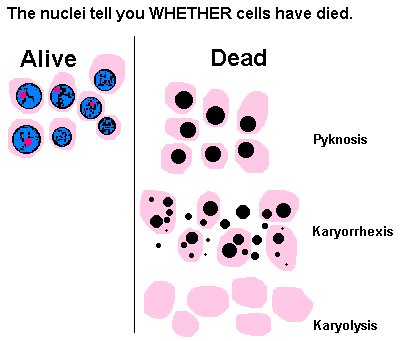
HOW DO YOU TELL A CELL IS DEAD? For a moment, ignore the various types of longstanding necrosis.
(1) As it is dying, the cell cytoplasm becomes hypereosinophilic (loss of ribosomes is probably less important since the hue changes little; the denatured proteins probably expose more arginine and lysine units that bind eosin).
(2) If the cell was burning glycogen in life (heart, maybe liver), the glycogen is gone. This makes the cell smaller, more homogeneous, and more intensely-pink-staining.
(3) Nuclear pyknosis, karyorrhexis, and karyolysis, as above, are the easiest ways to tell that cells are dead. Especially while you're learning, rely on these.
Later on, the cytoplasm starts looking "moth-eaten" as lysosomal enzymes digest the cell. By this time, we stop talking about "dead cells" and start talking about "debris".
Words: AUTOLYSIS is the dead cell being self-digested by its lysosomal enzymes, while HETEROLYSIS is the cell being digested by the body's living white cells. After death of the person, all the tissues autolyze, and the skilled pathologist must distinguish these changes from necrosis during life. (When there's antemortem necrosis, there's generally some vital reaction among the surviving cells, i.e., inflammation, congestion, a recognizable pattern of infarction at the organ level, a thrombus, etc., etc. More about this later.) PUTREFACTION is the lysis of dead tissue (part of a live body, or a dead body) by bacterial enzymes, producing nasty smells. The champions are clostridia from the bowel.
|
{07195} putrefied corpse from the woods
|
 Billy Crystal as the gravedigger in "Hamlet" |
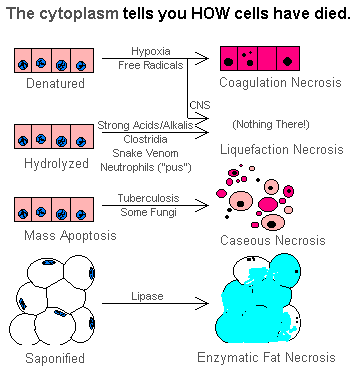
TYPES OF NECROSIS is a topic that generates tremendous confusion among students. These patterns are not hard-and-fast.
COAGULATION NECROSIS: Death of groups of cells (most often from loss of blood supply), with persistence of their shapes for at least a few days.
Grossly, the dead area is likely to be soft and pale. After a while, it is likely to shrink (catabolism) and turn yellow (its lipids are freed up to form little micelles, trapping the tryptophan metabolites that impart the yellow color to normal body fat).
You'll see coagulation necrosis when it is the result of proteins being denatured (i.e., ischemia, extensive free radical injury). Think of frying eggwhite.
![]() Coagulations necrosis
Coagulations necrosis
Proximal renal tubule
ERF/KCUMB
|
|
|
|
The microscopy is distinctive. After loss of their nuclei, the cytoplasm of the cells remains intact for days. The "tombstones" reveal the structure of the living tissue. If the patient lives, the edges of the necrotic area become inflamed, and eventually the dead cells will be removed by white cells and their noxious proteases. RULE: Unless otherwise specified in this section, the death of a group of cells will result in coagulation necrosis.
Depending on circumstances, necrotic tissue may be walled off by scar tissue, totally converted to scar tissue, get destroyed (producing a cavity or cyst), get infected (producing an abscess or "wet gangrene"), or calcify. Of course, if the supporting tissue framework does not die, and the dead cells are of a type capable of regeneration, you may have complete healing. You'll learn about all these processes in the next few days.
* Necrosis, but not apoptosis, releases the NLRP3 inflammasome, which I'd never heard of until this was published in J. Immuno. 183: 1528, 2009. This is probably something that lets dying cells signal distress. Other substances released from necrotic cells that bring in inflammatory cells: J. Crit. Care Med. 37: 2000, 2009.
Remember: True coagulation necrosis involves groups of cells, and is almost always accompanied, after a day or so, by acute inflammation (next unit!) Apoptosis does not cause inflammation.
Also remember: As you try to sort out the various mechanisms of damage in necrosis by contrast with apoptosis, keep in mind that in necrosis, at least some membranes are always damaged, while in apoptosis, membranes stay intact.

{39659} Necrosis of the hip, gross specimen with crumbling bone (Bo Jackson's disease)
{05956} Focal necrosis of hepatocytes. A glycogen-is-dark-red counterstain here makes the live
hepatocytes red, dead hepatocytes more pink
{08828} Widespread necrosis of hepatocytes; they're gone from most of the field, all that is left is
endothelial cells and Kupffer cells; there is a central vein in the center of the picture
{13320} Massive necrosis of the liver (limp liver;
nothing is left in the lobules except endothelial cells and reticulin)
{49266} Massive necrosis of the liver ("yellow atrophy");
we would want a histologic picture to confirm our gross impression
{13322} Massive necrosis of the liver with loss of most hepatocytes, histology, in fatal hepatitis
{16952} Necrosis of renal papillae (orange-yellow;
the bright yellow at the bottom is kidney fat)
{09578} Neuron, newly-dead ("red neuron")
{10571} Renal cortical necrosis (note yellow color)
{17389} Coagulation necrosis of renal tubules (left side)
APOPTOSIS ("shrinkage necrosis", "single-cell coagulation necrosis", "natural death in contrast to necrosis") is a distinct reaction pattern that represents programmed single-cell suicide. Cells actually expend energy in order to die. (Reviews Science 292: 865, 2001; Science 293: 1784, 2001). Brenner, Horvitz, and Sulston won the Nobel Prize in 2002 for their work on apoptosis. Still good reads about apoptosis: JAMA. 279(4):300, 1998; Am. J. Med. 107: 489, 1999.
There are two basic routes to apoptosis:
In apoptosis, the cell membrane does not rupture, the cell contents are not released into the extracellular space, and inflammation does not occur.
Apoptosis is "the physiologic way for a cell to die", seen in a variety of circumstances. You may see some apoptotic cells near cells that have been injured in other ways.
The basic biology of apoptosis is the same regardless of the circumstances:
1. The process often starts when a surface suicide receptor is stimulated (fas/Apo1 product, "the death trigger", etc.; Nature 367: 317, 1994; J. Imm. 151: 621, 1993)
2. The common point-of-no-return seems to be leakage of cytochrome C from the damaged mitochondria (Am. J. Med. Sci. 318: 15, 1999, lots more)
3. Endonucleases slice the genome between each pair of nucleosomes (Am. J. Path. 136: 593, 1990) -- experimentalists see DNA ladders on agarose gel electrophoresis;
* One of the endonucleases comes from damaged mitochondria: Nature 412: 90 & 95, 2001.
4. A transglutaminase crosslinks glutamine and lysine units by their side-nitrogen atoms (this may cause the edges of the cells to bleb and fragment);
5. A caspase degrades the cytoskeleton.
| In apoptosis, the nucleus and cytoplasm condense (i.e., they shrivel and stain dark), and are likely to fragment, but they will remain solid, and end up as mummified remnants ("apoptotic bodies"). |

|
Cells connected to their neighbors (i.e., epithelial cells) detach cleanly as they die. The most famous
of these is the "Councilman body" ("acidophil body")
of viral liver disease. Apoptotic cells may be phagocytized by
their neighbors. Unlike
coagulation necrosis![]() and liquefaction necrosis, there is never any
rupture of the cell membrane, the surrounding cells are alive,
and the debris does not excite an inflammatory reaction.
and liquefaction necrosis, there is never any
rupture of the cell membrane, the surrounding cells are alive,
and the debris does not excite an inflammatory reaction.
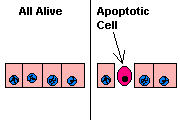
{05961} apoptotic hepatocyte ("Councilman body") in hepatitis B (shrivelled, hypereosinophilic, separated from its neighbors)
* We now have special research techniques to show up, definitively, which cells are apoptotic in a section. Most popular with the researchers is "terminal deoxyribonucleotidyl transferase mediated nick end labelling" (TUNEL). For the working pathologist, there are immunostains, perhaps the best being an antibody against cleaved caspase 3. Update Histopathology 44: 9, 2004; other stains are required when other caspases are involved (J. Histochem. Cytochem. 57: 289, 2009).
Apoptotic nuclear pyknosis, karyorrhexis, and karyolysis look, morphologically, like what you see
in other necrosis. The difference is that apoptosis features individual cells dying off, and a lack of
inflammation.
We've learned a lot about what triggers apoptosis, and this impacts treatments. Worth knowing:
The bcl-2 gene product inhibits apoptosis by coating
the mitochondria and not letting the cytochrome C out.
Mutant expressions
(as in
some cancers) prevent cells from dying when they should.
The fas ligand, when stimulated, triggers apoptosis.
When tumor necrosis factor (TNF) binds to its receptor (TNF ligand;
Nat. Med. 5: 157, 1999),
it stimulates apoptosis.
CTL-lymphocytes (killer "T"'s) trigger the fas ligand,
and also use perforin to pierce the cell membrane and
inject their granules, where granzyme B
activates the caspase.
The p53 gene product instructs damaged cells to undergo apoptosis.
This is the most common gene known to be
lost in aggressive cancers.
NECROPTOSIS is a variant on necrosis, with membrane damage but signalling resembling apoptosis,
though without caspases. It's a putative mechanism in steatohepatitis and some other illnesses.
I wouldn't worry about it as a classroom pathology student.
PYROPTOSIS is another programmed cell death, this one involving inflammasomes and releasing
interleukin-1. Cells affected by intracellular microbes (macrophages with typhoid bacilli,
T-cells with HIV) explode and the interleukin attracts other cells that fight infection.
* Future pathologists: The chromatin in a cell
undergoing apoptosis tends to clump under the nuclear membrane, i.e.,
clockface.
EFFEROCYTOSIS is a new term for the removal
of apoptotic bodies (see for example Chest 129: 1673, 2006).
It is probably defective in at least some of the immune-mediated diseases.
More about this later.
OTHER VARIANTS ON COAGULATION NECROSIS:
One variant of coagulation necrosis is the CONTRACTION BANDS seen in dying heart muscle. These are strips of cytoplasmic hypereosinophilia perpendicular to the long axis of the fiber (not to be confused with cross-striations). They are typically the first light-microscopic indication of heart cell death, and represent areas in which sarcomeres have clamped shut. (Some experimentalists attribute their appearance to "reperfusion injury", with calcium entering the damaged cells. This seems very reasonable.)
{06642} contraction band necrosis in heart
{06651} contraction band necrosis in heart (there are also neutrophils)
Coagulation necrosis of skeletal muscle fibers (or something very similar) is sometimes called ZENKER'S HYALINE CHANGE. Segments of individual fibers shrink and become hypereosinophilic.
LIQUEFACTIVE / LIQUEFACTION NECROSIS (* "colliquative necrosis" in Europe): The result of hydrolysis. When the cells die, they are rapidly destroyed by lysosomal enzymes, either their own or those from neutrophilic leukocytes (i.e., bacterial infections), or clostridia or snake poison (for example, keepers of illegal pet Gaboon vipers will want to read Clin. Tox. 45: 60, 2007). Acid and lye burns represent the extreme of liquefaction. Also, if both neurons and glia are killed, dead brain liquefies rapidly.
Liquefactive necrosis that is caused by neutrophilic leukocytes is called PUS. The term may also be used for an effusion that is full of dead neutrophils. Because of the extensive protein hydrolysis (i.e., more total molecules), there's a tremendous increase in the osmotic pull. This explains the familiar high-pressure in a ripened pimple -- and deep in the brain, for example, this is even more serious.
NOTE: The truism that "brain liquefies" is a common source of misunderstanding. Brain deprived of its oxygen for a few moments will suffer neuronal damage but not necrosis. Brain deprived of blood flow for a few moments longer will lose neuronal structure but not glia, and remain solid. The same is true of diseases in which neurons die off one at a time (i.e., Alzheimer's disease causes the brain to shrivel but not to liquefy). Only if the glia are also killed does the brain melt away, and then only after several days.

{17399} old liquefactive necrosis, brain, gross
{17400} old liquefactive necrosis, brain, gross
|
|
NOTE: Menstruation actually involves liquefaction of the endometrium. Nobody talks about the term in this way.
(ENZYMATIC) FAT NECROSIS: When pancreatic enzymes are released into the body's tissues, they digest them wholesale. Lipase releases free fatty acids (saponification) from the local lipids (membranes, depot triglyceride). This complexes with calcium ions to form salts (calcium stearate, etc.) that are notoriously insoluble -- ask a plumber, or anyone who's had a bathtub ring or grunge after washing dishes in hard water. Years later, survivors still have soap deposits in their insides.
Hematoxylin stains calcium very blue, and fat necrosis appears as blue cell ghosts on H&E stains. The pattern is sufficiently distinctive from classic "coagulation" and "liquefaction" to merit a term of its own.

{17404} enzymatic fat necrosis, gross; patches of white
calcium stearate
{17403} enzymatic fat necrosis, microscopic (right side);
calcium imparts the blue tinge
{08348} enzymatic fat necrosis, microscopic (right side)
Non-enzymatic "fat necrosis" can also follow physical
injury (remember a blow to the breast) or hypoxic injury to
a newborn (you'll see this under the skin), and freed fats
can calcify.
CASEOUS NECROSIS (same root as "cheese" and "casein"): All of the cells
in an area die, the tissue architecture is obliterated,
and they turn into a crumbly ("friable"), readily-aerosolized powder.
This is a distinctive type of "necrosis"
seen in diseases in which
there is an intense immune reponse.
Details are poorly understood.
You'll usually see it in certain granulomatous diseases, notably tuberculosis The cells appear to be undergoing mass apoptosis (I predicted this in 1986;
confirmation came from immunostaining Eur. J. Immunol.
27: 3182, 1997; Infect. Immun. 65: 298, 1997;
and most recently J. Clin. Path. 61: 366, 2008).
This makes sense -- and also explains why caseous necrosis tends to be
white rather than yellow (as in coagulation and liquefaction necrosis). In a mummified apoptotic cell, there's less separation of lipid and water
than in coagulation necrosis, so there's no lipid phase to be yellow.
It is now well-established that cell-mediated immunity
against the tubercle bacillus is essential for, and immediately
precedes, the appearance of caseous necrosis
(Antimicrob. Agents Chemother.
47: 833, 2003).
Update on the component of the tubercle bacillus
that causes caseation: Am. J. Path. 168: 1249, 2006.
But despite "Big Robbins", don't expect there
will always be a nice granuloma walling off the caseous debris -- especially TB {08187} renal TB, good caseous necrosis (right side, left is normal)
GANGRENE ("gangrenous necrosis") is not a separate kind of necrosis at all, but a term for necrosis
that is advanced and visible grossly. If there's mostly
coagulation necrosis {17392} dry gangrene
BACTERIAL GANGRENE
occurs when the primary problem is infection by one or two strains of bacteria,
and widespread tissue necrosis occurs in short order. Examples:
CLOSTRIDIAL GANGRENE (including "gas gangrene"), a dread complication of dirty, blood-deprived
wounds. The clostridia digest tissue enzymatically and rapidly, often transforming it into a bubbly
soup, usually too fast for inflammation to develop. Minutes count.
SYNERGISTIC GANGRENE after surgery, a mixed infection with
staphylococci ULCERATIVE GINGIVITIS ("trench mouth"), caused by overgrowth of anaerobes in the mouths of stressed
people with dubious oral hygiene.
NOMA, necrosis of the lower face and/or female genitalia, seen only in people who are
immunocompromised (usually from severe malnutrition; Am. J. Trop. Med. 78:
539, 2008).
* FOURNIER'S GANGRENE, bacterial gangrene of the scrotum (the dreaded "black sack disease" -- no joke;
get seen at a specialty hospital J. Urol. 182: 2742, 2009.)
CAVITATION results from removal of necrotic material (i.e., draining a huge abscess, coughing up
caseous FIBRINOID NECROSIS is a time-honored term for damage to the walls of arteries that allows plasma
proteins to seep into, and precipitate in, the media (some pathologists call this "insudation"). This is
a particularly unwholesome situation. You'll learn the common causes (notably malignant
hypertension and type III / immune complex immune injury) later. It's hard to be sure that anything here is really dead,
but at least the intima must have been damaged.
{01917} fibrinoid necrosis, blood vessel, following radiation (fibrinoid is pink)
* GUMMATOUS NECROSIS is, for our purposes,
coagulation necrosis * NECROBIOSIS is a curious term for necrosis of fibroblasts within
still-intact dense fibrous tissue. It's
characteristic of two lesions -- necrobiosis lipoidica and granuloma annulare.
NOTE: If a person dies of acute coronary insufficiency (i.e., a sudden drop in blood supply to the
heart triggered a fatal rhythm disturbance or pump failure), no necrosis will be found in the
myocardium at autopsy. This generates much confusion among non-pathologists.
But already it is time to depart, for me to die, for you to go on living; which of us takes the better
course, is concealed from anyone except God. -- Socrates To die will be an awfully big adventure!
Let us so live that when we come to die even the undertaker
will be sorry.
I am going to the great Perhaps.
-- Rabelais, last words
ALTERATIONS WITHIN IN THE LIVING CELL
LYSOSOMES: For some reason, "Big Robbins" reviews the basic cell biology of lysosomes here. It's
common (especially in full-type phagocytes) to see a bacterium or bit of debris within a
phagolysosome (HETEROPHAGOCYTOSIS). You may also see an organelle being digested within a
phagolysosome (AUTOPHAGOCYTOSIS). A RESIDUAL BODY is a phagolysosome filled with already-digested debris, and
in lysosomal storage diseases, they fill with metabolites that patients cannot
break down.
* Chloroquine raises the pH in lysosomes and renders
their enzymes less active.
PROLIFERATION OF SMOOTH ENDOPLASMIC
RETICULUM: Overgrowth of the drug-metabolizing equipment of
drug-exposed liver cells. (We prefer the term "proliferation" for this process, rather than
"hypertrophy" or "hyperplasia".) We can tell by the cell's light microscopic appearance, but we
won't ask you to do this.
MITOCHONDRIAL ALTERATIONS are cited by "Big Robbins". Giant mitochondria are seen in alcoholic
(and
other) liver disease, odd mitochondria are hallmarks of certain muscle diseases, and occasionally
weird ones are seen in cancer.
More familiar is the process of "getting in shape" by physical conditioning. This process probably
involves increasing the efficiency (though maybe not appearance, size, or
numbers)
of mitochondria in affected muscles. Leave this to the physiologists.
Certain cells become literally stuffed with mitochondria. In health, these include the apocrine sweat
glands of the armpits, and the "oxyphil" cells of the parathyroid glands. In disease, such cells are
generically called HüRTHLE CELS or ONCOCYTES (the latter, which means "swollen cells", is a terribly
confusing word.)
CYTOSKELETON PROBLEMS are currently under much study. For your reference:
MICROTUBULES...
20-25 nm (* the vinca drugs used for chemotherapy bind these,
thus preventing mitosis from being completed)
MYOSIN...
15 nm (in muscle) or 8 nm (non-muscle)
INTERMEDIATE FILAMENTS...
10 nm
ACTIN...
6- 8 nm (* experimentalists: prevent these from forming
using cytochalasin B)
CHEDIAK-HIGASHI SYNDROME is a genetic white cell disease in which microtubule protein fails to
polymerize. This isn't the whole story, since the major problem that these people have is failure of
lysosomes to fuse with phagocytic vacuoles.
COLCHICINE disrupts microtubules, while CYTOCHALASIN B disrupts microfilaments.
Defects in the DYNEIN ARMS OF THE MICROTUBULES within cilia cause infertility in both sexes, problems
keeping the airways clean, and sometimes problems in getting the embryo's guts into the right places.
More on these ("Kartagener's syndrome" and others) later.
The intermediate filaments are supposed to keep organelles in their positions. They include
KERATIN
(for epithelium; there are several subtypes), NEUROFILAMENTS,
GLIAL FILAMENTS,
VIMENTIN (for
mesenchyme), and DESMIN (for muscle). MALLORY'S HYALINE in the boozer's liver is scrambled
prekeratin, while NEUROFIBRILLARY TANGLES in the brains of Alzheimer's patients and injured
boxers are
composed of tau protein, a microtubule-associated protein.
* More than you ever wanted to know about the intermediate filaments, including mutations that
cause some of the hereditary skin diseases collectively called EPIDERMOLYSIS
BULLOSA: Science 25:
799, 1992; update Arch. Derm. 137: 1458, 2001.
Even the cell membrane has its own underlying skeleton, including the protein
SPECTRIN, which when
deficient prevents the erythrocytes from assuming the forms of biconcave disks. (The patients have
HEREDITARY SPHEROCYTOSIS, a fairly common disease. More about this later.)
DEVELOPMENTAL ABNORMALITIES: This covers a host of anatomic lesions in which "things
grew wrong". This is a terminology section.
CONGENITAL DISEASE can be shown to be present from birth.
(Note that some genetic diseases do not announce themselves clinically
until much later in life, and injuries to the unborn child can result
in congenital, non-genetic disease.)
APLASIA is the complete failure of an organ to form. (By a time-honored misuse, wipe-out of once-healthy bone marrow
is called "aplastic anemia").
{15939} kidneys never formed ("renal aplasia / agenesis"; organ block of newborn child; the kidneys
should be next to the small intestine)
ATRESIA is the complete failure of the lumen, or a portion of the length of the lumen, to form where it
should in a hollow organ..
STENOSIS is a non-neoplastic narrowing of a lumen; it may be a birth defect, or acquired.
Not birth defects, but you need to know: OCCLUSION is the complete obstruction of a lumen that was
once open. SPASM is the narrowing or occlusion of a lumen due to inappropriate contraction of
smooth muscle, or the inappropriate contraction of skeletal muscle anywhere.
HYPOPLASIA is the failure of an organ to grow to normal size
along with the rest of the body. (By another time-honored misuse,
bone marrow with too-few cells is called "hypoplastic", even if it was once normal). "Atrophy"
would be a better term.
{15632} hypoplasia of the nails (minor birth anomaly)
LOCAL GIGANTISM is just as it sounds (the
"Elephant Man", Nixon's masseters -- noted
syndrome, see J. Oral. Max. Surg. 52: 1199, 1994 -- others that you know).
MALFORMATION: Something was shaped wrong since the beginning.
DEFORMATION: Something used to be well-formed, but its shape was permanently altered, other than
by being cut apart.
You are welcome to call both malformations and deformations "deformities".
SYN- and HOLO- are prefixes that indicate failure to separate ("syndactyly" is fused fingers;
"holoprosencephaly" is a brain without divided hemispheres). Failure to fuse has no special word
root, but is also important ("hypospadias" is failure of a male's urethra to fuse; "harelip" you know).
SUPERNUMERARY ORGANS often recall those of other animals (very common are supernumerary nipples
-- who's got one? -- and the less-visible accessory spleens), or might-have-beens in the history of life
(polydactyly, i.e., six fingers on a hand, six toes on a foot).
ECTOPIA / HETEROTOPIA is a well-formed bit of organ in the wrong place. If it's tiny and trivial, it's a
HETEROPLASIA (for example, the common sebaceous glands on the buccal mucosa, called "Fordyce
granules"). If it's big enough to interest a surgeon, it's called a
CHORISTOMA. HAMARTOMAS are the right components of an organ in the wrong arrangement. The best-known hamartomas are
the vascular and pigmented birthmarks, and most "benign tumors of blood
vessels" are really hamartomas.
Like "real tumors", hamartomas can be clonal, indicating origin from a single mutated cell post-lyonization: Am. J. Path.
148: 1089, 1996. If you do not remember what lyonization is, this would be a good
time to review. Unlike real tumors, most hamartomas grow along with the body at about the same rate.
There's plenty waiting to be discovered.
{05756} cartilage hamartoma, lung (trust me; your
lung is supposed to contain cartilage, in its bronchial walls,
but not a cartilage golfball like this)
CYSTS are abnormal, closed, fluid-filled structures. Most definitions also stipulate that they be lined
by epithelium (I'd consider those that don't to be wrong). Many (but by no means all) cysts are
developmental defects, left over from embryogenesis.
* In due time, you'll learn about "retention cysts" (resulting from plugged ducts), "implantation
cysts" (after a bit of epidermis grows within the dermis following trauma), "hydatid cysts" (brood
cavities for tapeworms), "hyperplastic cysts" (i.e., part of the common, banal "fibrocystic disease of
the breasts"), cysts that form within tumors, "pseudocysts" (generally large cavities lined by partially-digested
fat cells), and "cystic changes" resulting from
liquefaction necrosis {25559} mucous cyst, within the lip
FISTULAS are abnormal openings between body surfaces. SINUSES, when
not part of normal anatomy, are pathological
openings from an abnormal fluid-containing cavity
onto surfaces / an apparent fistula track to nowhere. If they're present for more than a very short time, each will epithelialize (of
course, why?) Either may sometimes represent a developmental defect.
{49228} anal fistula
A DIVERTCULUM is an outpouching of the entire wall of a tubular organ. This is most often a birth
defect or the result of something pulling on the side of the tube for a long time.
A PSEUDODIVERTICULUM is an outpouching of the mucosa through a weakness in the wall of a tubular
organ. This is most often the result of too-high pressure for too long in the lumen.
ATROPHY: "Shrinkage in the size of the cell by loss of cell substance" ("Big Robbins"), without
the cell actually dying. When many cells each become smaller, the organ itself become smaller.
Defined this way, atrophy is very reversible.
Examples of real atrophy are:
Wasting of skeletal muscle on disuse (casted extremity, couch potato,
diaphragm of a patient on a ventilator NEJM 358: 1327, 2008); wasting of
the myocardium of a bed-ridden
patient or a weightless astronaut (1%/day, NEJM 358: 1370, 2008)
{14424} atrophy of type II fibers in a couch potato
Loss of innervation of skeletal muscle (polio * The molecular biology, which of course involves inhibition of RNA transcription, is just now being
worked out (Proc. Nat. Acad. Sci. 91: 3647, 1994).
Diminished blood supply (various organs -- this includes "pressure atrophy") or inadequate nutrition
(various organs).
Loss of normal trophic stimulation, for example endocrine stimulation. This is very important; most organs that depend for their function on
endocrine stimulation (adrenals, testes, a man's skeletal muscles) will diminish in size if the
stimulating hormone is no longer available.
* Chronic inflammation in the area -- maybe. Nobody knows why chronic gastritis
ultimately causes atrophy of the mucosa.
{17447} atrophy of thyroid (left; right side is normal thyroid at much lower magnification)
"Aging" is cited by "Big Robbins", though I am not impressed that geriatric cases have appreciably
smaller cells when all other things are equal.
As cells take part in atrophy, especially by loss of size, the extra proteins are disposed of using
ubiquitin ligases and proteasomes as you'd expect. Organelles may be eaten in phagolysosomes
("autophagy").
Cell loss is most of the story in the brain.
Lower sex hormonal levels explain atrophy of tissues dependent on them -- here
the cells truly get smaller, and in the breast may vanish.
Bone loss and thinning of the dermis as we age aren't well understood -- again, cells are lost rather than shrink.
The other organs simply don't atrophy in healthy old age. Purists use the
term "involution" for decrease in cell or organ size as a result of the
maturation/aging process (i.e., "the thymus
undergoes involution later in childhood").
Atrophic cells have fewer organelles and do not function as well as their normal counterparts. As
cells atrophy, their lysosomes consume their organelles. Again, some of the debris is non-digestible
and ends up as lipofuscin -- contributing to "brown atrophy".
Especially when the cause of atrophy is inadequate blood supply or nutrition, the atrophic cells may
go on to die and be replaced by scar tissue and/or fat. Probably in all the cases listed above except
for skeletal muscle, there is loss of individual cells.
* You may run into the term AUTOPHAGY for cells in distress eating their
organelles for protein synthesis. We can now detect the involved molecules;
not surprisingly, it's part of the downward cycle in congestive heart failure
(Circ. 120(11-S): S-191, 2009). There is now talk about "autophagic cell death",
in contrast to apoptosis and necrosis -- stay tuned to see if this becomes a standard
term in pathology.
{10247} atrophy of a kidney supplied by a narrowed artery ("ischemic atrophy")
Looser usage allows the word "atrophy" to be used for widespread loss of cells (usually by
apoptosis, if you catch them dying at all), without shrinkage of survivors. This misnomer has been
hallowed by long tradition when applied to the brains of heavy drinkers, Alzheimer's disease, and the
elderly.
{10847} brain "atrophy" (wide sulci, narrow gyri)
![]() Enzymatic fat necrosis
Enzymatic fat necrosis
White flecks
WebPath Photo
![]() Caseous necrosis
Caseous necrosis
TB -- it does look like cheese
WebPath Photo
![]() Caseous necrosis
Caseous necrosis
Mycobacterial lymphadenitis
UMDNJ.
![]() and certain fungal infections
(coccidioidomycosis
and certain fungal infections
(coccidioidomycosis![]() ,
blastomycosis
,
blastomycosis![]() ,
and histoplasmosis
,
and histoplasmosis![]() -- you'll learn these later).
-- you'll learn these later).
![]() in the
AIDS-and-homelessness era!
in the
AIDS-and-homelessness era!
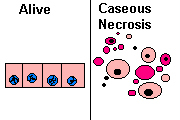
{17395} pulmonary TB, caseous necrosis of the lung, gross
{17396} pulmonary TB, caseous necrosis of the lung, micro
(all is crumbly; on the left the nuclei are lost indicating that it is more advanced)
![]() ,
(i.e., the typical
blackening, desiccating foot that dried up before the bacteria
could overgrow), we call it DRY GANGRENE. If there's mostly
liquefactive necrosis
,
(i.e., the typical
blackening, desiccating foot that dried up before the bacteria
could overgrow), we call it DRY GANGRENE. If there's mostly
liquefactive necrosis![]() (i.e., the
typical foul-smelling, oozing foot infected with several different kinds of bacteria), or if it's in a wet
body cavity, we call it WET GANGRENE.
(i.e., the
typical foul-smelling, oozing foot infected with several different kinds of bacteria), or if it's in a wet
body cavity, we call it WET GANGRENE.
{25451} dry gangrene
{25452} dry gangrene
{48075} dry gangrene
{48076} dry gangrene
{25453} early gangrene
{25454} wet gangrene (bacteria-rich)
{25455} gangrene of the toe, relatively early
{17393} gangrene of the bowel ("wet")
{10655} infarct of hand following embolus to brachial artery
{38590} gangrene of the fingers
![]() Synergistic bacterial gangrene
Synergistic bacterial gangrene
Progressive post-operative
necrotizing lesion
![]() Anthrax
Anthrax![]()
Inoculation site
KU Collection
![]() Foot Gangrene
Foot Gangrene
Australian Pathology Museum
High-tech gross photos
![]() and streptococci
and streptococci![]()
![]() debris in tuberculosis
debris in tuberculosis![]() , physiologic removal of debris in a cerebral infarct, etc.)
, physiologic removal of debris in a cerebral infarct, etc.)
{53545} fibrinoid necrosis, blood vessel, in a vasculitis syndrome
(fibrinoid is the pink center ring)
![]() seen in granulomas in
syphilis
seen in granulomas in
syphilis![]() . I've
seen this only in study-sets.
. I've
seen this only in study-sets.
-- Peter Pan (James Barrie)
-- Mark Twain

Neil Gaiman's "Death"
Character fan art
The boundaries that divide Life from Death are at best
shadowy and vague. Who shall say where the one ends,
and the other begins?
-- Edgar Allen Poe, "The Premature Burial"
* Amiodarone, the heart rhythm drug, binds to phosopholipids in
lysosomes and renders them insoluble.
![]() Syndactyly
Syndactyly
From a Saddam-era Iraqi
propaganda website (!)
An organ that developed in the wrong place may be ECTOPIC (for example, a kidney in the pelvis); * you may hear
the term "dystopia".
{28889} cartilage and cuboidal cell hamartoma, lung, microscopic view (the right components,
i.e., cartilage and glands, but the
wrong arrangement)
{49278} bile duct hamartomas, liver (trust me)
{49638} cardiac muscle hamartomas ("rhabdomyomas", trust me), tuberous sclerosis patient;
identify the bumps without the normal heart muscle fiber pattern
![]() in brain, mesenchymal tumors, or
elsewhere.
in brain, mesenchymal tumors, or
elsewhere.
{25560} mucous cyst, being excised
{25569} cysts of the breast
{09652} synovial cyst, ankle; it has been cut and the thick, gooey fluid has poured out
{12504} epidermoid inclusion ("sebaceous") cyst, beneath skin
{16982} polycystic kidney (football-sized; more about this later)
{16983} polycystic kidney
{49336} cyst of the epididymis (the testis is the white structure)
{49396} mucinous cystadenoma of the ovary; this might have weighed 30 pounds or more
{49471} thyroglossal duct cyst
{49472} thyroglossal duct cyst, filled with jelly-like thyroglobulin
{17445} atrophy of arm and chest muscles after nerve injury
{17446} atrophy of most muscle cells after nerve injury
{53704} atrophy of the left arm after a stroke
{14372} Werdnig-Hoffman disease of motor nerves; most muscle cells underwent atrophy
![]() ,
nerve damage, nerve disease)
,
nerve damage, nerve disease)
As we'll see later,
an older adult who stays fit (for example, Dennis
Quaid, show here at age 53) can out-perform almost all of today's
nintendo-playing teens in any test of physical fitness.
{25767} atrophy of a kidney supplied by a narrowed artery ("ischemic atrophy")
{17448} ischemic atrophy of renal tubules in a high blood pressure patient (left side)
{33047} ischemic atrophy of a cerebral hemisphere in chronic vascular disease
{34403} ischemic atrophy of a cerebral hemisphere in chronic vascular disease
{34478} brain "atrophy" (wide sulci, narrow gyri)
{34481} brain "atrophy" (wide sulci, narrow gyri)
{49554} atrophy of the cerebral peduncle following a stroke involving the motor cortex
Another classic misuse is "atrophy of the testes" seen in dudes on anabolic steroids, which suppress
LH production by the adenohypophysis. So they lose their germinal epithelium (which accounts
for most of the mass of a man's testis.) Or following torsion or mumps![]() .
Wait until the male
contraceptive pill becomes available....
.
Wait until the male
contraceptive pill becomes available....
{10898} "Testicular atrophy", gross, with a normal for comparison
{00086} "Testicular atrophy", adult man, no spermatogenesis whatsoever
![]() Testicular atrophy.
Testicular atrophy.
Maybe mumps or old torsion.
WebPath Photo
Bone marrow becomes less cellular in old age and in some illnesses.
{39457} bone marrow "atrophy"; only 20% of the marrow is hematopoietic cells (low even for old age), 80% is fat
And we routinely talk about "atrophy of the caudate nucleus in Huntington's chorea", "atrophy of the exocrine pancreas when the duct is obstructed", etc., etc., etc., when we really mean loss of cells instead.
{15426} atrophy of the gastric fundus mucosa in an elderly patient; smooth, shiny (i.e., thin epithelium), no rugae
Now is as good a time as any to introduce CACHEXIA, catabolism of body tissues, mediated by the cytokines (substances by which white blood cells talk to one another and to the surrounding tissues).
You have probably already seen a cachectic cancer or AIDS patient, the most familiar situations. The muscles of the body, and some other important tissues, are destroyed and energy liberated while the fat is burned less. Widespread apoptosis may be taking place as well, especially in AIDS.
You can distinguish cachexia from marasmus (total-calorie malnutrition) because of selective loss of muscle rather than fat. You can tell it from kwashiorkor (protein malnutrition, not exactly rare, either) by the absence of fatty change in the liver. More about this later.
Cancer and AIDS patients are also likely to have poor appetites and to be low on fat as well; adults may weigh as little as 60 lb. when they finally die, and death itself may be due to loss of the muscle strength necessary to cough or even breathe.
HYPERTROPHY: Increase in the sizes of cells, and hence the size of the organ.
|
|
There are only a few examples:
Hypertrophy of the muscles of a strength athlete
| {18668} "built up"; hypertrophied muscles
{18642} "built up"; hypertrophied muscles |
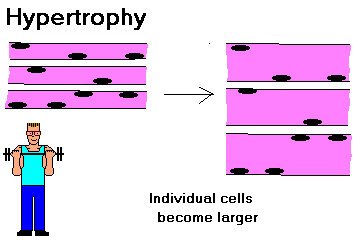
|
* Hypertrophy of the muscles of a person with a birth defect causing increased muscle tone ("myotonia congenita", not very serious)
Hypertrophy of the hard-working heart of an aerobic athlete, obese person, hypertensive person, person with aortic valve stenosis, etc.
* Abnormal hypertrophy is critical to the development of common congestive heart failure, where the heart is twisted out of shape and rendered inefficient. Different genes are activated, and these may become targets for therapy (Nat. Med. 11: 877, 2005; p27Kip1 Nat. Med. 14: 315, 2008; Ann. Thorac. Surg. 88: 1916, 2009.)
* Hypertrophy of the muscles of a person or animal deficient in myostatin, a protein responsible for the atrophy of unused muscle
{03347} cardiac hypertrophy (either side, normal in center; the giveaway is the giant nuclei)
{06380} cardiac hypertrophy (left), normal on right
{06383} cardiac hypertrophy (left), normal on right
{17454} cardiac hypertrophy (left), brown atrophy on right
![]() Myostatin-deficient cow
Myostatin-deficient cow
Muscle hypertrophy
Watch this one
Hypertrophy of heart or skeletal muscle fibers, when their neighbors have been lost to disease.
Not surprisingly, there are genes, at least in cattle (J. Animal Sci. 76: 468, 1998) and mice (Nature 387: 83, 1997, growth factor alleles), to have more or less hypertrophied muscles; these are now being discovered in humans to explain the natural differences in muscularity. (* Angiotensin-converting enzyme: J. Clin. Endo. Metab. 86: 2200, 2001 -- perhaps why men who are "easy-gainers" in bodybuilding tend to become hypertensive earlier in life).
Hypertrophy of portions of the heart in people who have inherited an abnormal beta-myosin gene ("Reggie Lewis's disease", much more on this later.)
Hypertrophy of the smooth muscle cells of the uterus in pregnancy (also undergo hyperplasia, see below)
Most endocrine organs, when stimulated for a long time, show some cellular hypertrophy. Hyperplasia is the predominant change.
* Hypertrophy of astrocytes when the brain is damaged ("gemostocytes").
* Hypertrophy of the good liver cells while the liver is repairing itself.
* Hypertrophy of liver cells bearing increased smooth endoplasmic reticulum, i.e., in response to medications that stimulate the P450 system.
* Nobody says this, but the fat cells in an overweight person are technically hypertrophic (unless you define hypertrophy to be increase in cell size due to more functional units.)
It's no surprise that cells undergoing hypertrophy have "increased protein synthesis", increased numbers of organelles, etc. We have almost no understanding of the mechanisms of hypertrophy, or its limits.
Hypertrophic cells, especially in the heart and endocrine glands, often have extra complete chromosome sets, having gone through S-phase one or more times. Cardiac muscle cells, normally tetraploid (did you know that?) become octaploid or 16-ploid. Endocrine cell nuclei become very large, etc., etc.
Testosterone seems to help build or rebuild skeletal muscle throgh a host of signal pathways (Endocrinology 151: 628, 2010).
The distinction between "pathologic" and "physiologic" hypertrophy is showcased in the heart, which may enlarge due to athleticism (physiologic) or increased resistance to blood flow through the body (pathologic).
We discourage the use of "hypertrophy" as a generic term for any increase in size of an organ, in the absence of significant increase in cell size ("benign prostatic hypertrophy"; skin calluses as "hypertrophy", etc.)
HYPERPLASIA:
"When an organ grows by increasing the number of its cells" -- R&F. By definition, the cells appear normal. This may be physiologic ("Big Robbins" distinguishes "compensatory / growing back " and "hormonal / working overtime" -- in health, it's probably all mediated by molecules), or pathologic (i.e., the result of genetic mutations or environmental changes).
* Expect in the near future to find genetic injuries that drive "pathologic hyperplasias" that are so familiar in the prostate and endometrium.
|
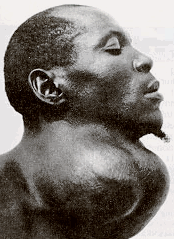 Thyroid hyperplasia in endemic goiter |
Examples:
The female breast at puberty -- under the influence of estrogens -- and during pregnancy and lactation (additional hormones). (NOTE: The breast also undergoes hypertrophy.)
{49360} idiopathic "hypertrophy" of one breast. Actually, this is probably the result of an embryonic mutation, hence best considered a neoplasm.
The endometrial glands and stroma during the menstrual cycle
![]() Endometrial hyperplasia.
Endometrial hyperplasia.
Latter portion of cycle.
WebPath Photo
The male breast in cirrhosis or estrogen therapy, or in some boys at puberty ("gynecomastia") -- all reflect estrogens
* A host of common but poorly-understood benign proliferations in the breast, some of which foreshadow increased risk of breast cancer (Surg. Clin. N.A. 93: 299, 2013).
Lymph nodes in response to infection
The callused skin of a laborer's hand or a corn on a foot with an ill-fitting shoe (in addition to more keratin, the epidermis itself thickens)
Smooth muscle cells in the pregnant uterus (also undergo hypertrophy)
Adrenal cortex in response to extra ACTH ("stress", ACTH-producing tumor, defective cortisol synthesis)
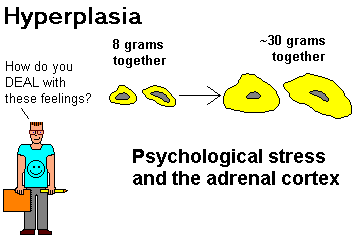
{09217} adrenal cortex ("stressed"; compare a normal, otherwise this is hard to appreciate)
Renal tubules in the remaining kidney following removal of the other -- mechanism unknown
Bone marrow normoblasts ("erythroblasts", "baby reds") following hemorrhage / blood donation -- under the influence of erythropoietin

Bone marrow myelocytes in response to infection -- under the influence of colony-stimulating factors
Liver growing back after donation of a lobe. (There are a bunch of molecules involved, but the liver cells do seem to know when there's not enough of them on board. The liver's shape won't be the same, but who cares?)
Leydig cells in the testes of men with Klinefelter's syndrome or elderly men -- they don't produce much androgen, so high gonadotropin levels drive them to multiply.
{24694} testis with Leydig cell hyperplasia (the cells between the tubules with the abundant eosinophilic cytoplasm; this shows lots too many of them)
Thyroid cells under the influence of hTSH ("epidemic goiter", due to iodine deficiency), autoimmune stimulation of hTSH receptors ("Graves' disease"), or unknown factors ("idiopathic goiter")
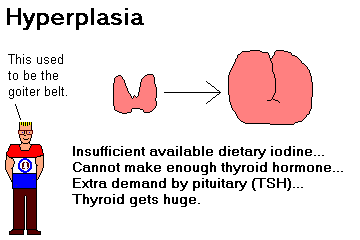
Thyroid cells in response to autoantibody attack with stimulation of hTSH receptors ("Grave's disease")
Parathyroid cells in renal failure
Epidermal cells in a wart (the virus is tricking the body into making extra cells for it to live in and spread from)
{49450} parathyroid gland hyperplasia (they're big, trust me)
Bladder epithelial cells in bladder infections -- mechanism unknown
Endometrial cells in illness -- under the influence of unknown factors ("hyperplasia of the endometrium", an important cause of irregular bleeding)
{49376} endometrial hyperplasia (uterus has been opened anteriorly; the hyperplastic endometrium appears as a blob)
The prostate in old men -- under the influence of unknown factors (or perhaps genetic programming).
|
|
{10743} prostatic hyperplasia (paper clip demonstrates urethral stenosis)
{24827} sebaceous gland hyperplasia
* Epidermis overlying certain curious dermal lesions
(blastomycosis![]() ,
granular cell tumor) -- this
"pseudoepitheliomatous hyperplasia" looks grossly and microscopically like cancer.
,
granular cell tumor) -- this
"pseudoepitheliomatous hyperplasia" looks grossly and microscopically like cancer.
* Proliferation of mesothelium whenever there's something wrong in the pleural space. Telling this from mesothelioma is one of the toughest and most troublesome calls in pathology (Arch. Path. Lab. Med. 136: 1217, 2012.)
Various tissues under the influence of drugs
* The islets is Langerhans after gastric bypass surgery for weight reduction. Figure THAT one out! NEJM 353: 249, 2005.
* The intima in a vein graft -- this is extremely important clinically and still a major mystery: Ann. Surg. 257:: 824, 2013.
* Overgrowth of the neointima within a vascular stent. Again, this is not well-understood (J. Am. Coll. Card. 59: 2051, 2012).
{25557} hyperplasia of gingival tissue in a patient receiving phenytoin ("Dilantin") therapy (this is often misnamed "hypertrophy")
Contrary to what you have been told, heart muscle cells are quite capable of dividing. For some reason, they undergo hyperplasia rather than hypertrophy in the remodelling, failing hearts of the elderly: J. Am. Coll. Card. 24: 140, 1994; and after myocardial infarction. Update Lancet 363: 1306, 2004.
Also contrary to what you've been told, there is some cell division in the skeletal muscles of bodybuilders that remains when the gymrat lays off but enables more rapid gains on resumption of exercise ("Muscles have a memory"). It is much less important than the hypertrophy.
Various tissues where a gene has mutated and given the cell a growth advantage over its neighbors, but in which the cells still appear more or less normal (for example, pancreas Cancer 92: 1807, 2001 & Am. J. Path. 144: 889, 1994; lung J. Clin. Path. 54: 257, 2001 & Virch. Archiv. 424: 129, 1994; bladder 89: 514, 2000; parathyroid Am. J. Path. 147: 1600, 1995).
NOTE: Hyperplasia usually doesn't happen in neurons, cardiac/skeletal muscle (except as noted above), or cartilage; because these cells are usually incapable of division.
* When the hyperplasia is useful, textbooks call it "physiologic", and make the distinction between "hormonal" (part of growing up) and "compensatory" (in response to injury). When the hyperplasia isn't useful, the books call it "pathologic". These distinctions are artificial and not necessary to an understanding of the processes. Probably the physiologic hyperplasias don't result from mutations.
Notice that most hyperplasias seem to result from hormonal stimulation. As a rule, when the hormone is removed, the hyperplasia quickly reverses.
Of course, hyperplasia resulting from genetic mutations conferring a growth advantage will not reverse. This increases the likelihood of a future cancer at this site.
METAPLASIA: "(Adaptive) substitution of one type of adult or fully differentiated cell for another type of adult (or fully differentiated) cell" -- Baby Robbins. "A reversible change in which one adult cell type replaced by another adult cell type." -- Big Robbins. "Conversion of a differentiated cell type into another" -- R&F.
Examples:
Replacement of airway pseudostratified mucin-producing ciliated columnar epithelium by
a somewhat-stratified
epithelium (cigaret![]() smokers -- "to protect our delicate tissues from the harsh effects of
smoke").
smokers -- "to protect our delicate tissues from the harsh effects of
smoke").
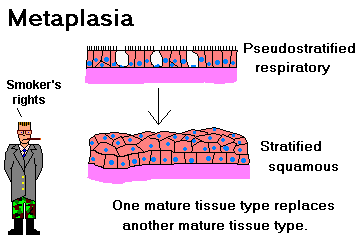
* Despite what you have been told about the protective effect of this metaplasia, we seldom see anything more than a little reserve cell hyperplasia in casual sections of smokers' lungs. It you see real stratified squamous epithelium, there's usually a squamous-cell lung cancer nearby, and thus the squamous metaplasia was due to mutations. More about this later.
Replacement of the ruined epithelium of the trachea and bronchi by a stratified squamous metaplasia in influenza (Am. J. Clin. Path. 133: 380, 2010 for photos)
Transformation of the gallbladder or urinary bladder epithelium to stratified squamous epithelium
in the presence of foreign bodies (stones,
schistosome eggs![]() )
)
Replacement of airway pseudostratified mucin-producing ciliated columnar epithelium by an epithelium consisting almost entirely of goblet cells (cigaret smokers and asthmatics)
Replacement of the columnar mucoid epithelium of the endocervix by stratified squamous epithelium in women infected with wart virus
Replacement of most columnar and transitional epithelium by stratified squamous epithelium, and replacement of corneal epithelium by heavily-keratinized epithelium (vitamin A deficiency)
Replacement of fibrous tissue by calcified bone (many scars, which in the real world may be considered "normal")
Replacement of laryngeal, tracheal, and costal cartilages by bone (old age)
Replacement of normal gastric epithelium with intestinal epithelium in stomach disease ("intestinalization")
{15432} stomach mucosa with intestinal metaplasia (right;
there's a bit of dysplasia/anaplasia as well); normal at left
{19347} stomach mucosa with intestinal metaplasia (goblet cells, etc.)
Replacement of transitional bladder epithelium by mucin-producing epithelium ("cystitis glandularis", a misnomer since there's no inflammation)
Replacement of flat simple squamous epithelium by cuboidal epithelium (damaged alveoli, hurt mesothelial surfaces). This is temporary and is a stage in repair -- you can call it "metaplasia" if you want.
Development of bone, often complete with hematopoietic marrow, within a blind, shrunken eye.
* Development of bone in the corpus cavernosum following papaverine treatment of impotence (J. Urol. 142: 1323, 1989)
Replacement of columnar epithelium by squamous epithelium in the prostate, under the influence of exogenous estrogens (administered for the treatment of prostate cancer) or adjacent to an infarct.
Replacement of squamous epithelium by columnar (gastric-type) epithelium in "Barrett's" esophagus, caused by reflux-and-repair in the presence of some genetic mutations that give a growth advantage to stomach-type cells (the molecular biology has become enormously complex: Gastroent. 138: 854, 2010).
{19453} columnar metaplasia ("Barrett's" change) of esophageal mucosa (note the goblet cells)
Just how "adaptive" most these changes are seems dubious, but all are metaplasia.
Some epithelial metaplasias are reversible if there is an identifiable stimulus that can be removed (which is rare). Mesenchymal metaplasias (despite "Big Robbins") are probably not reversible. Ignore anything that anybody may tell you about "metaplasia by definition is reversible".
As with hyperplasias, certain metaplasias (notably, most Barrett's esophagus and many gastric intestinalization cases) result from mutated genes that have given a clone of cells a growth advantage over their neighbors. You'll only get rid of these if you remove the clone itself (as in aggressive treatment of Barrett's esophagus) or change the environment that gives the mutant cells an advantage (as in removing helicobacter from a stomach).
DYSPLASIA ("atypia", "atypical hyperplasia", "pre-cancer", "intraepithelial lesion", etc.; word favored by Dr. Papanicolaou and losing favor lately): "Bad growth". This has always meant abnormal cell organization. By convention today, unless otherwise specified, this implies a very abnormal epithelium with "loss of uniformity of the individual cells, as well as a loss of their architectural orientation". This includes "atypical hyperplasia" and "atypical metaplasia" as well as the oxymoronic old term "intra-epithelial neoplasia".
Unqualified, "hyperplasia" and "metaplasia" imply the tissue cells look normal. In dysplasia, they look distinctly abnormal, and the changes resemble those seen in cancer cells, but have not yet invaded. These weird changes are called ANAPLASIA. Look for:
Cells of varying sizes and shapes, lying topsy-turvy (i.e., the cells have forgotten how to be good neighbors)
Less of the familiar differentiating features appropriate for the organ (i.e., the cells are forgetting what to do)
Large, dark-staining nuclei with irregular surfaces (i.e., there's too many chromosomes, and the nucleus doesn't know how to pack them all)
Increased nuclear-cytoplasmic ratio (increased N/C ratio; i.e., there's a surplus of chromosomes and/or they've forgotten to make enough cytoplasm)
Frequent mitotic figures (but no really weird ones) -- often away from the basement membrane (i.e., at least some of the normal controls on cell division are suspended)
It might be reasonable to consider that "metaplasia involves the cytoplasm; dysplasia requires abnormal nuclei". The changes listed above are collectively called ANAPLASIA ("grow-down", "funny-looking cells"). The abnormal nuclei are the easiest way for the beginning to recognize anaplasia. We'll see them again, much more vicious, in the discussion of full-blown cancer.
* Virchow coined the terms "hypertrophy" and "hyperplasia". He called metaplasia "histological substitution", and called anaplasia / dysplasia "pathological substitution", and of course related the latter to cancer.
|
|
|
All dysplasias result from genetic changes that give cells a substantial growth advantage. The changes cited above are the result of these changes.
Ongoing injury (cigaret smoking, ulcerative colitis, reflex of acid into the esophagus) promotes the dysplastic process by causing increased cell division for repair. So the bad genes have a chance to propagate.
Examples:
A pre-cancerous Pap smear (dysplasia at the squamo-columnar junction of the cervix, with HPV infection an important part of the process)
{11490} dysplasia in the endocervix (upside-down; note N/C ratio, hyperchromatic cells, mitotic
figures off the basement membrane)
{39605} dysplasia in the endocervix (note N/C ratio, failure of maturation)
Ugly cells in the metaplastic bronchial epithelium next to (or a year prior to) an invasive lung cancer
Chaos in the intestinal epithelium in a long-term sufferer from ulcerative colitis or other inflammatory bowel disease (update Arch. Path. Lab. Med. 137: 338, 2013).
Chaos in a "benign colonic tumor" that was removed to prevent a future cancer
{11484} dysplasia in a colon polyp (note N/C ratio, crowding, loss of mucin production)
Chaos in the mucosa of the stomach in a patient at risk for stomach cancer
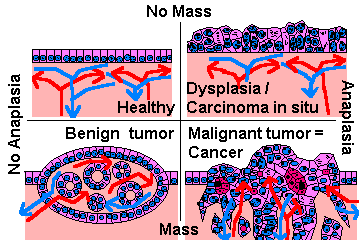
{15441} dysplasia in gastric mucosa (note N/C ratio, cells lying topsy-turvy)
Chaos in the urothelium in a patient with a frank bladder cancer elsewhere
{25297} urothelial dysplasia / maybe even carcinoma in situ (note N/C ratio, very large and hyperchromatic nuclei, topsy-turvy arrangement)
Red or white spots in the mouth of a tobacco-chewer -- when biopsied, the pathologist says "pre-cancerous"
Weird cells adjacent to an invasive prostate cancer: Hum. Path. 22: 644, 1991.
Like hyperplasias and metaplasias caused by mutations, a change in the environment may cause a mild dysplasia to regress. But be warned -- dysplasias are a breeding ground for deadly cancer. The ugliest anaplasias confined to epithelium have been called CARCINOMA IN SITU (better, "intraepithelial carcinoma"; in the most recent classification, simply "severe intraepithelial lesion"). Much more about this later.
{08911} carcinoma in situ of the endocervix, replacing epithelium and growing into a fold
{10079} carcinoma in situ of the bronchus
{11491} carcinoma in situ of the endocervix, replacing the columnar epithelium
* Ignore anything you may read in older textbooks about "teleology of dysplasia"; the process is NEVER useful.
* A second, confusing use of the word "dysplasia" means "tissues that formed with their components poorly arranged", for example, a scramble of muscle and fibrous tissue narrowing a renal artery.
IMPORTANT NOTE: It is now abundantly clear that atrophy, hypertrophy, hyperplasia, and metaplasia are all mediated, at least in part, by the same growth-and-differentiation genes ("proto-oncogenes") that function abnormally in dysplasia and cancer. By now, there are a tremendous number of examples, and I can share only a few.
* Healthy Harvey-ras mediates at least some of the hypertrophy of cardiac muscle in response to epinephrine and work (J. Clin. Invest. 89: 939, 1992); the gene product may work in part by turning on the fos gene (J. Biol. Chem. 268: 2244, 1993). Activated ras alone produces prostatic hyperplasia, at least in models (Cell 70: 153, 1992). Mutated Kirsten-ras begins to appear in dysplastic colon epithelium in ulcerative colitis (Gastroent. 102: 1983, 1992), and premalignant hyperplasia of the pancreas (J. Path. 186: 247, 1998). ras is among the most-mutated genes in full-blown cancer, and some types of cancer always feature a mutation here.
* A heavily worked skeletal muscle fiber expresses a tremendous amount of myc product within a few hours (Biochem. J. 281: 1433, 1992), as an early step in the process of undergoing hypertrophy.
* In squamous metaplasia adjoining squamous cell carcinoma of the bronchus, the over-expression of myc and p53 match the cancer (Lab. Invest. 68: 26, 1993).
Much, much more about this soon. When a mass has formed, i.e., when bizarre cells have figured out a way to grow their own blood supply, we talk about a new growth, i.e., NEOPLASIA.
Anaplasia is ugly cells, whether confined to an epithelium (dysplasia) or invading (cancer / malignant neoplasia).
Dysplasia is pre-cancer. Dysplasia is anaplasia confined to an epithelium and not yet invading. It is not yet really neoplasia.
If a neoplasm exhibits anaplasia, it is malignant (i.e., it is cancer), it will invade, and it will spread.
If a neoplasm does not exhibit anaplasia, it is benign, and will compress surrounding structures but will not invade of spread.
Well, usually. Stay tuned.
LOOKING AT ORGANS: You learn by doing.
-- Goethe
CONSISTENCY
Soft: Like your earlobe. Think of fat, lung, edematous loose connective tissue, pus, tumor with scanty stroma ("small blue cell" tumors, sarcomas)
Firm: Like your strongest, leanest muscle when you flex it. Most pathology specimens are mostly firm.
Hard: Like your knuckle. Think of bone, other calcified tissue, over-fixed dense connective tissue.
Remember the normal consistencies of organs, and that fixed organs are harder than unfixed ones.
COLOR
Red... Fresh blood or fresh myoglobin
Red-orange... Bilirubin; hemosiderin (sometimes)
Orange... Carotene
Yellow... Lipid (adipose tissue; adrenal cortex; coagulation necrosis, thick pus); elastic fibers (vessels; yellow ligaments)
Green... Biliverdin (formalin fixation reduces bilirubin to biliverdin)
Blue... Something non-white seen through a reflective surface (blood in your veins through your skin; carbon pigment under the pleura; blue iris; cornea in type I osteogenesis imperfecta).
Purple... Blood seen through a mucosal or serosal layer
White... Tumor; granuloma; collagen (fibrous tissue; scar; etc.); calcium flecks, real caseous necrosis
Gray... Lung alveolar tissue with some carbon
Brown... Feces; hemosiderin; lipofuscin; melanin; cytochromes (as in the liver); formalin-fixed or stale hemoglobin/myoglobin; debris
Black... Carbon ("anthracotic pigment"); very abundant melanin; homogentisic acid ("alkapton"); formalin-fixed hemoglobin turns dark brown or black; dry gangrene
LOOKING AT CELLS
In your histology course, you learned basic light-microscopic anatomy, techniques of slide preparation, and microscope use.
In this course, you will need to be able to tell what a cell was doing at the time it went into fixative.
Busy cells tend to have large nuclei and lots of euchromatin (since many of their genes are in use). If they're synthesizing much protein, they will usually exhibit a nucleolus (where ribosomes are made), and their cytoplasm will be bluish (from messenger, ribosomal, and transfer RNA).
Inactive cells will have smaller, darker nuclei and scanty cytoplasm. The body's least active cells include the resting memory lymphocyte and the tendon fibroblast.
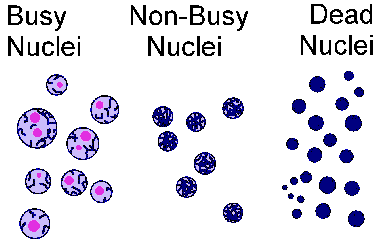
* For the curious: Heterochromatin is wound tight around nucleosomes. As genes are turned on, the chromatin structure is remodelled (Nature 367: 576, 1994).
All nuclei don't look alike, and it's time to start noticing the differences. Soon, you'll even be able to distinguish different kinds of white blood cells in tissue sections.

* PS: You'll learn "Death and the doctor" in other courses, i.e., how to break bad news, how to help families, what problems they will face caring for a dying relative, and so forth. Don't expect everybody to go through the classic five stages, especially where there is a living and decent religious faith. "Death education" isn't well done in most medical schools, at least the allopathic ones (Surgery 113: 163, 1993). Do yourself a favor and read a book by yourself over vacation.
If one person dies, it's a tragedy. If a million people die, it's a statistic.
-- Stalin
Once the game is over, the king and the pawn go back into the same box.
-- Italian Proverb
O sons of men,
Lean death perches upon your shoulder
Looking down into your cup of wine,
Looking down on the breasts of your lady.
Your are caught in the web of the world
And the spider Nothing waits behind it.
Where are the men with towering hopes?
They have changed places with owls
Owls who lived in tombs
And now inhabit a palace.
-- The Arabian Nights, 10th century
Life, like a dome of many-colored glass
Stains the white radiance of eternity
Until death tramples it to fragments.
-- Percy Shelley
In America today, the practices of medicine and law have so interfered with the dying process that death has become a perversion of the natural process.
-- Crit. Care Clin. 9: 613, 1993
Nor dread nor hope attend
A dying animal;
A man awaits his end
Dreading and hoping all.
-- Yeats, "The Winding Stair"
Socrates said, "O son of Hipponikos, the old proverb, 'Naught Without Labor' (chalepa ta kala), is applicable to learning. And nomenclature is no small part of learning."
-- Plato, Cratylus
Life is a comedy to those who think, a tragedy to those who feel.
-- Horace Walpole (usually misquoted and misattributed)
Chi-Lu asked Confucius how the spirits of the dead and the gods should be served. Confucius said, "You are not even able to serve other living people. How can you serve the spirits?" "May I ask about death?" said Chu-Li. "You do not understand even life. How can you understand death?"
-- Analects XI.12
To live will be an awfully big adventure!
-- Peter Pan, last paragraph
Death is before me today / like the recovery of a sick man / like going forth into a garden after sickness.
Death is before me today / like the odor of myrrh, / like sitting under a sail in a good wind.
Death is before me today / like the course of a stream; / like the return of a man from the war-galley to his house.
Death is before me today / like the home that a man longs to see,/ after years spent as a captive.
-- Ancient Egypt, c. 2000 BC
Get out! Get out! Last words are for fools who haven't said enough already!
-- Karl Marx's last words.
|
|
|
{18601} skull, a familiar symbol of human mortality
Today's scientific pathology had its inception in 1859 with Virchow's work. For his time, Dr. Still's ideas about disease were reasonably enlightened. Today's oath of the osteopathic physician promises that physicians will work together in a spirit of "progressive cooperation", that they will "keep in mind always nature's laws", and that they will "further the application of basic biologic truths to the healing arts and to develop the principles of osteopathy which were first enunciated by Andrew Taylor Still."
This course will focus on understanding disease in light of nature's laws as they really are, i.e., the principles of rational inquiry, and the essentials of physics, chemistry, and basic biology. At the human level, your study of pathology will constantly correlate physical structure and the function of the human being at every level, just as Dr. Still tried to do in the late 1800's.
The oath also makes the promise that you will always "keep in mind... the body's inherent capacity
for recovery." Most of pathology is the really study of this capacity. In this course, you will learn
how and when the body tends to heal itself, and how it fights off infection and repairs wounds. You
will always learn of situations in which the capacity to nourish and heal goes awry (atherosclerosis,
hypertension, autoimmunity), situations in which some phase of the power to heal is lacking
(hemophilia, immune deficiency), and situations in which the body does nothing to protect itself
(prion disease, Huntington's disease). You will also learn how the body wears out (Alzheimer's
disease), how damage accumulates and propagates itself (cancer), and how the body damages itself
fighting invaders (suppuration, tuberculosis![]() , rheumatic fever). You will come to understand when
you can intervene with the expectation of curing, and when you can only palliate and help the person
and family live with incurable illness.
, rheumatic fever). You will come to understand when
you can intervene with the expectation of curing, and when you can only palliate and help the person
and family live with incurable illness.
Dr. Still believed that the principles of disease are relatively straightforward, and urged learners to use the hands-on approach. Your course features an abbreviated lecture series coupled to a whole-person oriented lab experience in which you will be continually active.
The osteopathic oath-taker also promises to "be ever vigilant in aiding the general welfare of the community." Since Virchow, pathologists have considered public health and the politics of disease to be part of our discipline. There may not be easy answers, but the content is important.
I would like to think that an osteopathic medical education offers a common-sense, humane, and rational basis for treating disease, not just a welter of scientific facts for doctor-technicians. This isn't just "pathology with an osteopathic spin". It is how I think the subject should be taught everywhere.




BIBLIOGRAPHY / FURTHER READING
I urge anyone interested in learning more about the essential processes in pathology to consult these standard textbooks.
In my notes, the most helpful current journal references are embedded in the text. Students using these during lecture strongly prefer this. And because the site is constantly being updated, numbered endnotes would be unmanageable. What's available online, and for whom, is always changing. Most public libraries will be happy to help you get an article that you need. Good luck on your own searches, and again, if there is any way in which I can help you, please contact me at scalpel_blade@yahoo.com. No texting or chat messages, please. Ordinary e-mails are welcome. Health and friendship!
| New visitors to www.pathguy.com reset Jan. 30, 2005: |
Ed says, "This world would be a sorry place if people like me who call ourselves Christians didn't try to act as good as other good people ." Prayer Request

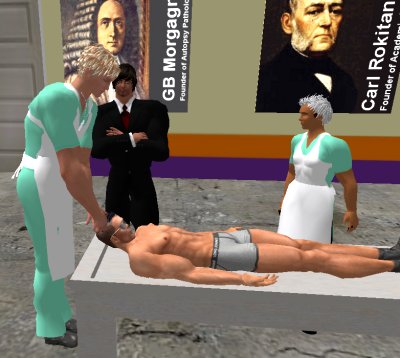
| If you have a Second Life account, please visit my teammates and me at the Medical Examiner's office. |
Teaching Pathology
 Ed's Pathology Review for USMLE I
Ed's Pathology Review for USMLE I
 | Pathological Chess |
 |
Taser Video 83.4 MB 7:26 min |
 |
Click here to
see the author prove you can have fun skydiving without being world-class. Click here to see the author's friend, Dr. Ken Savage, do it right. |
